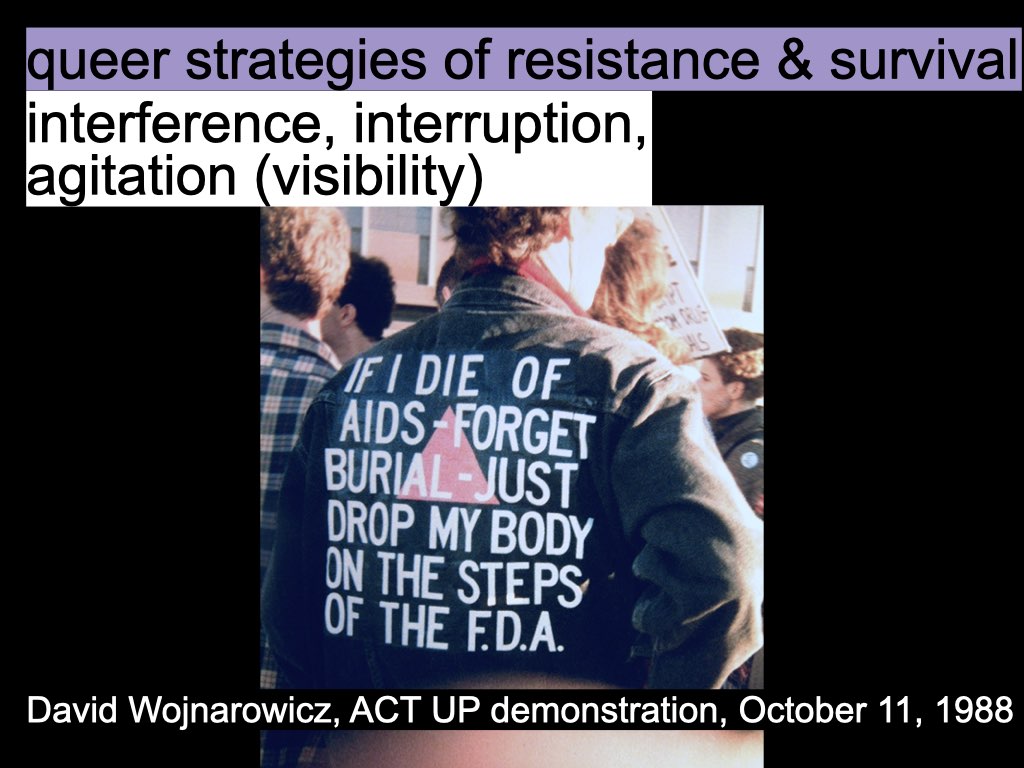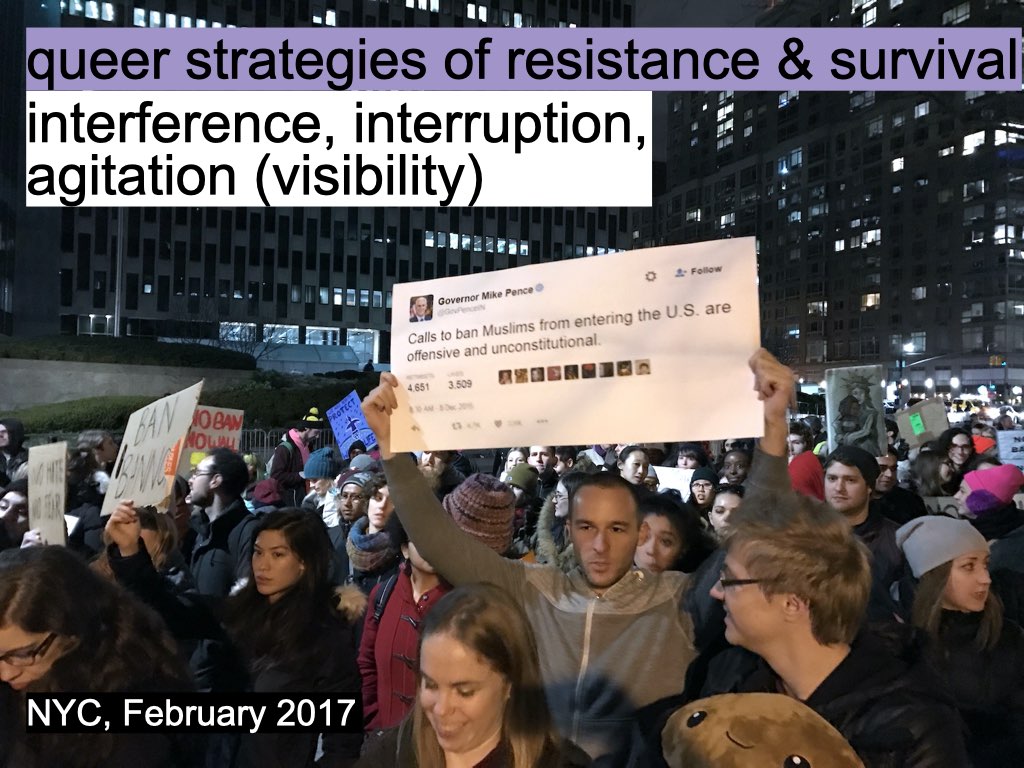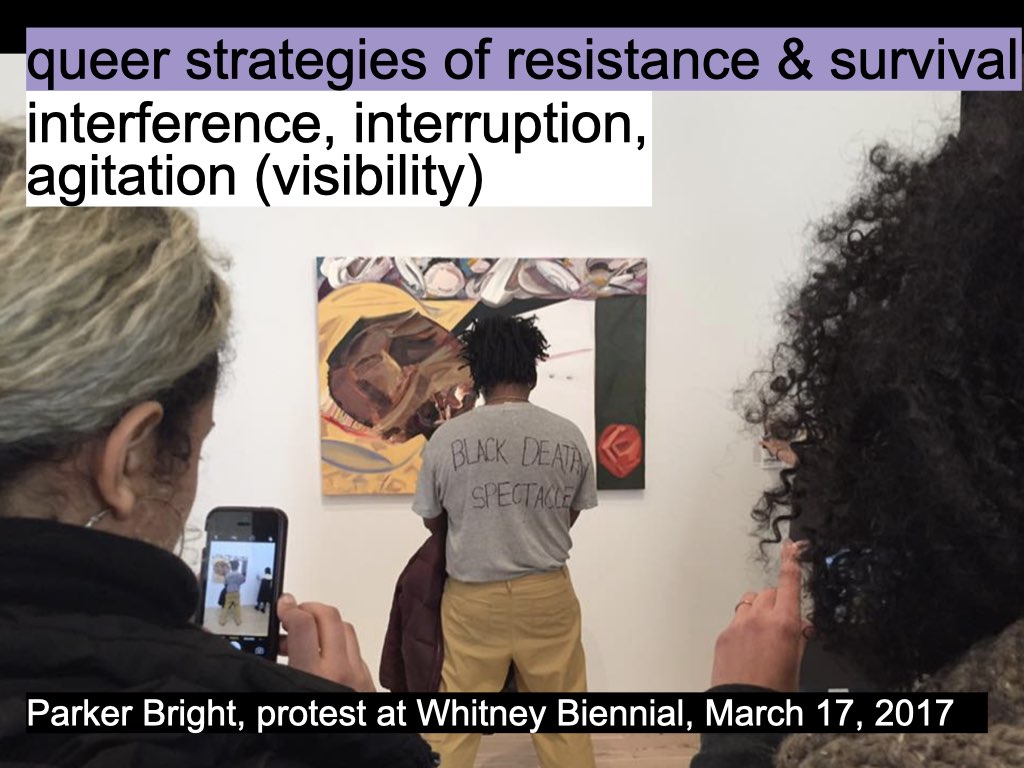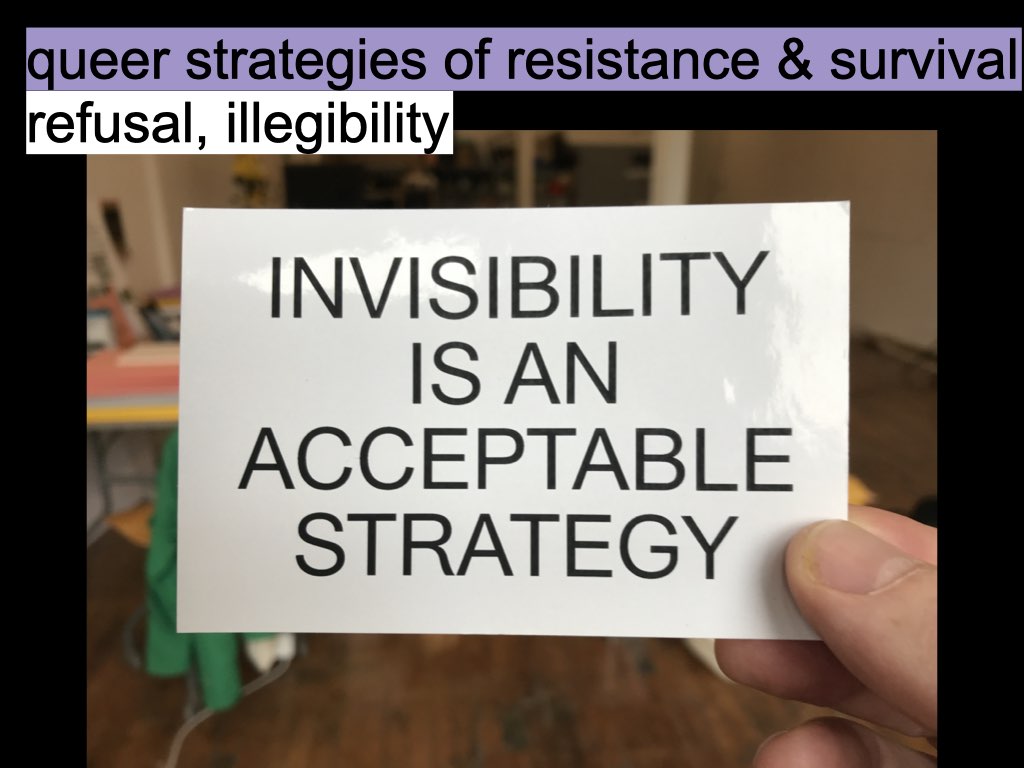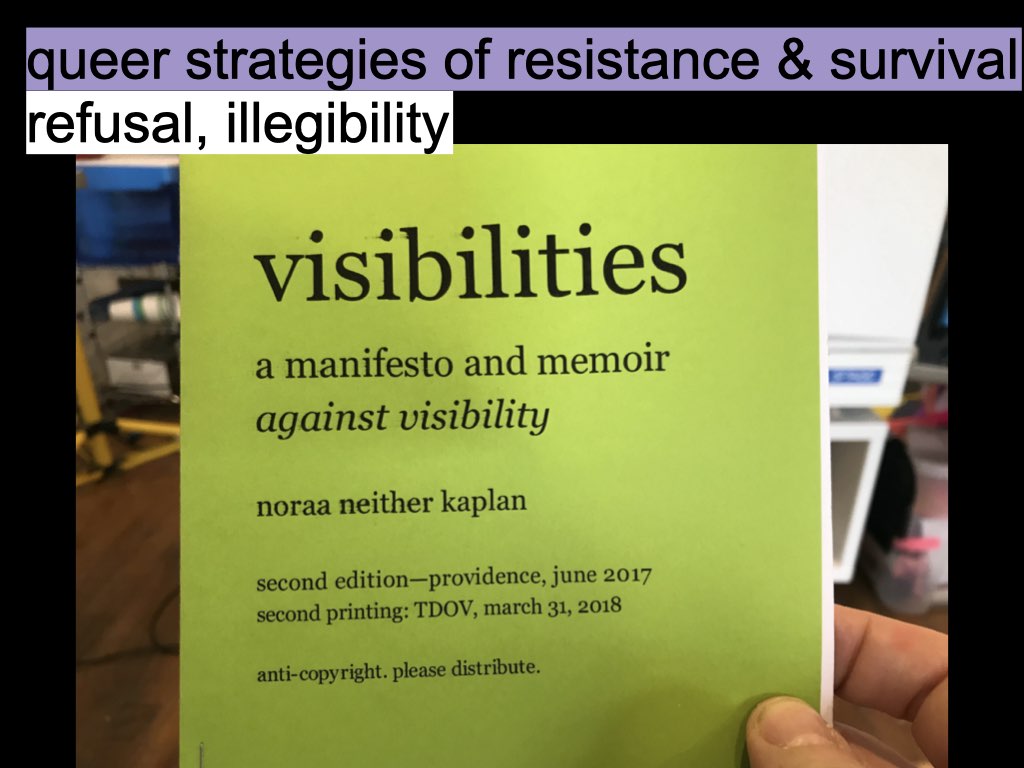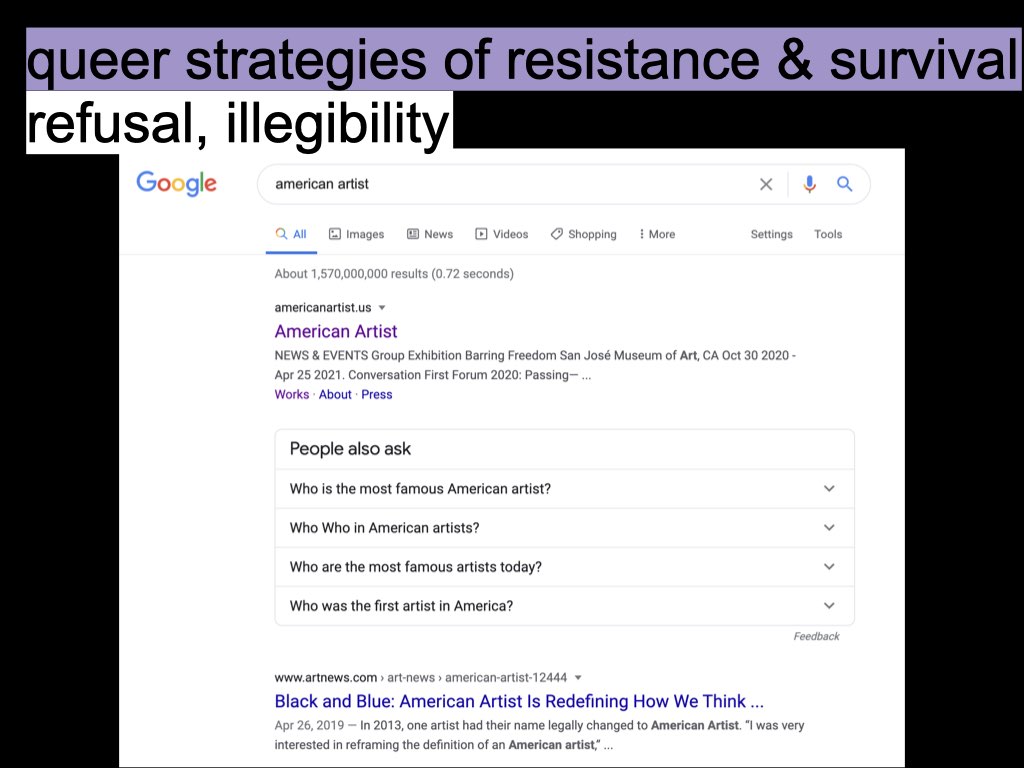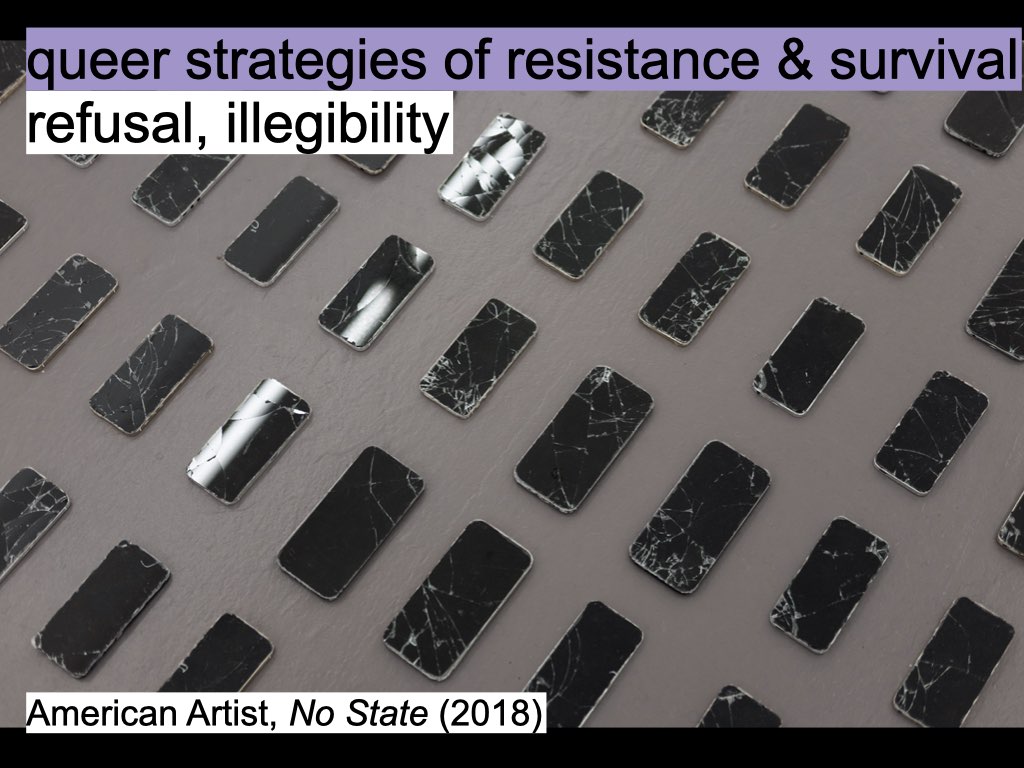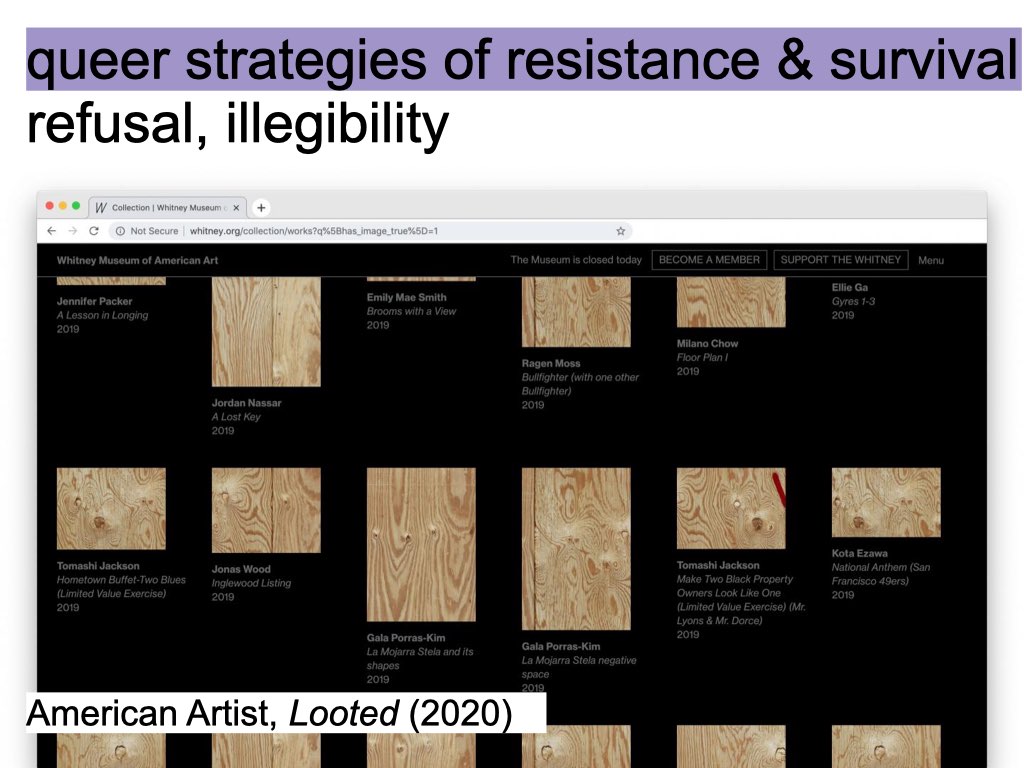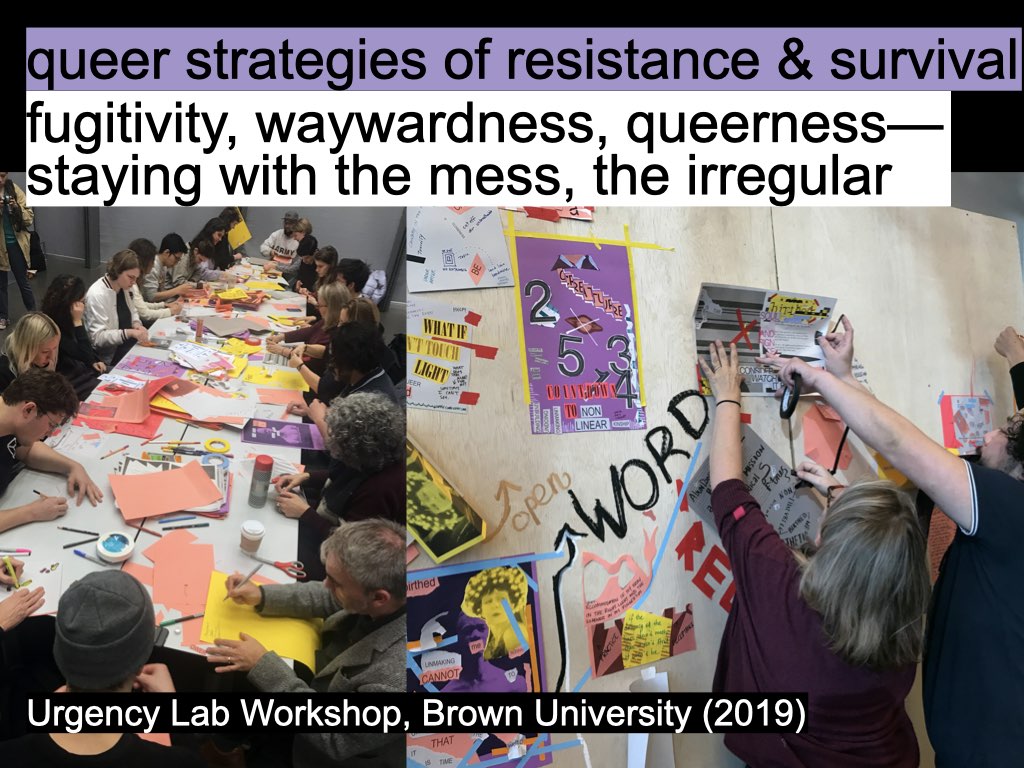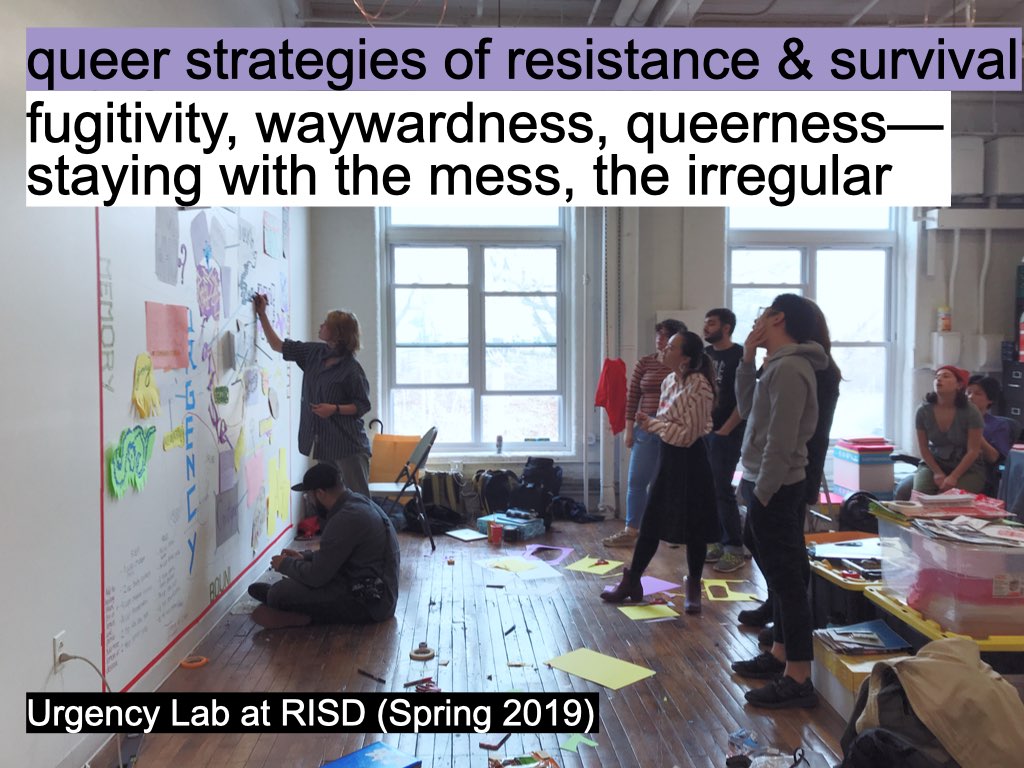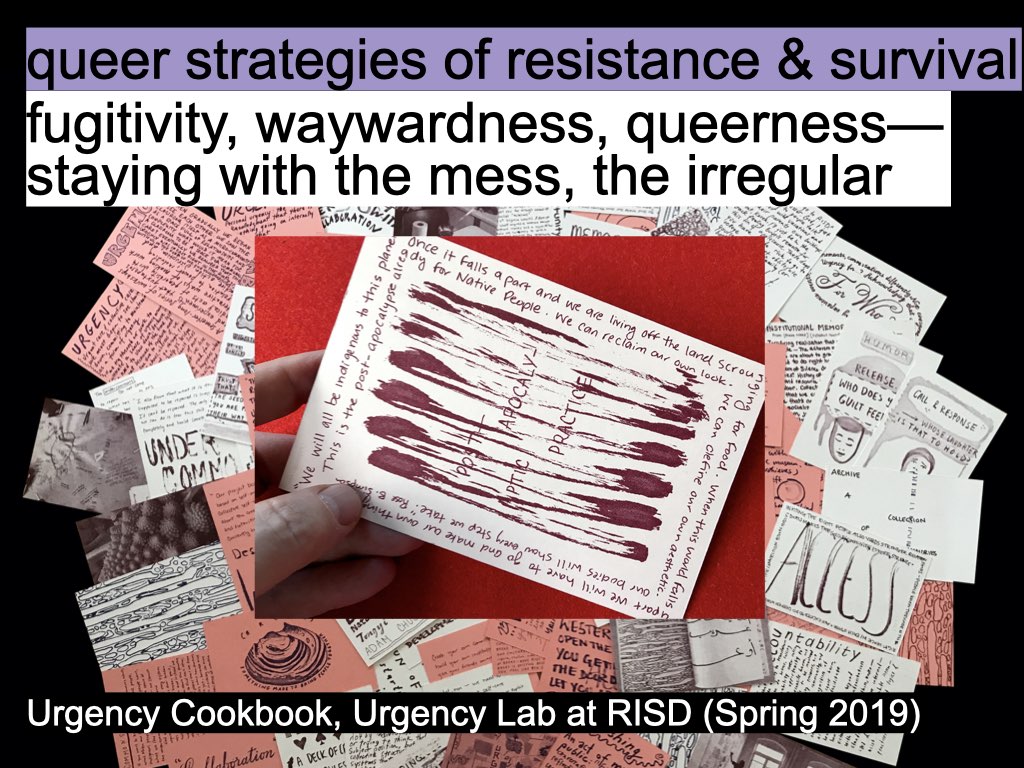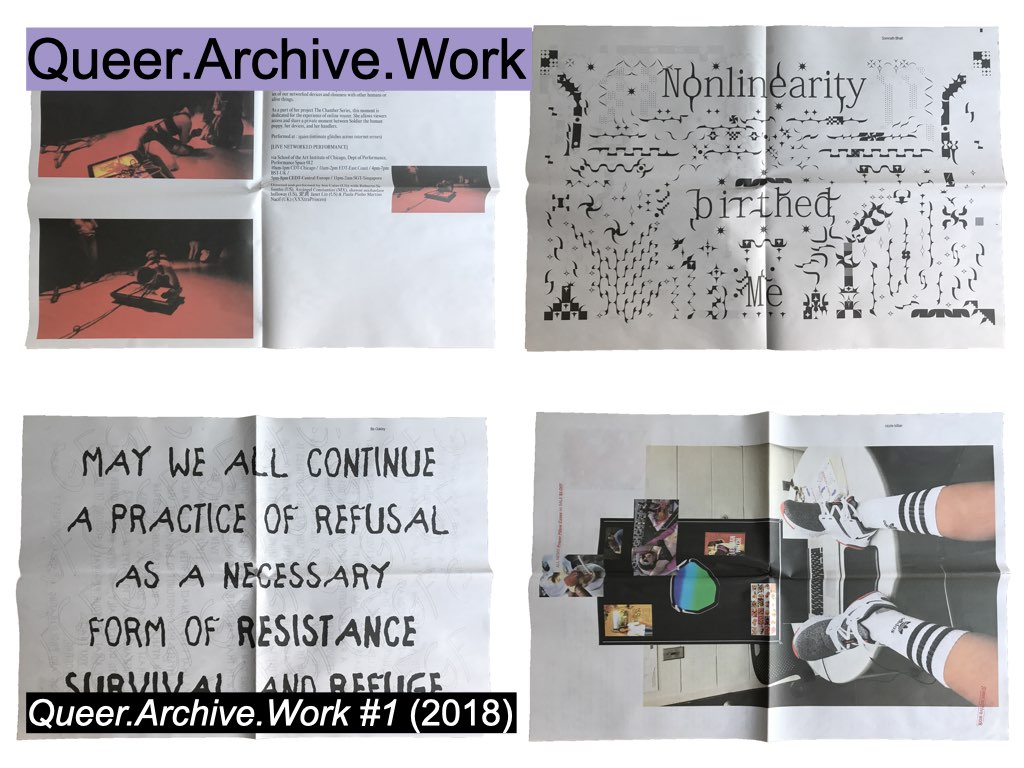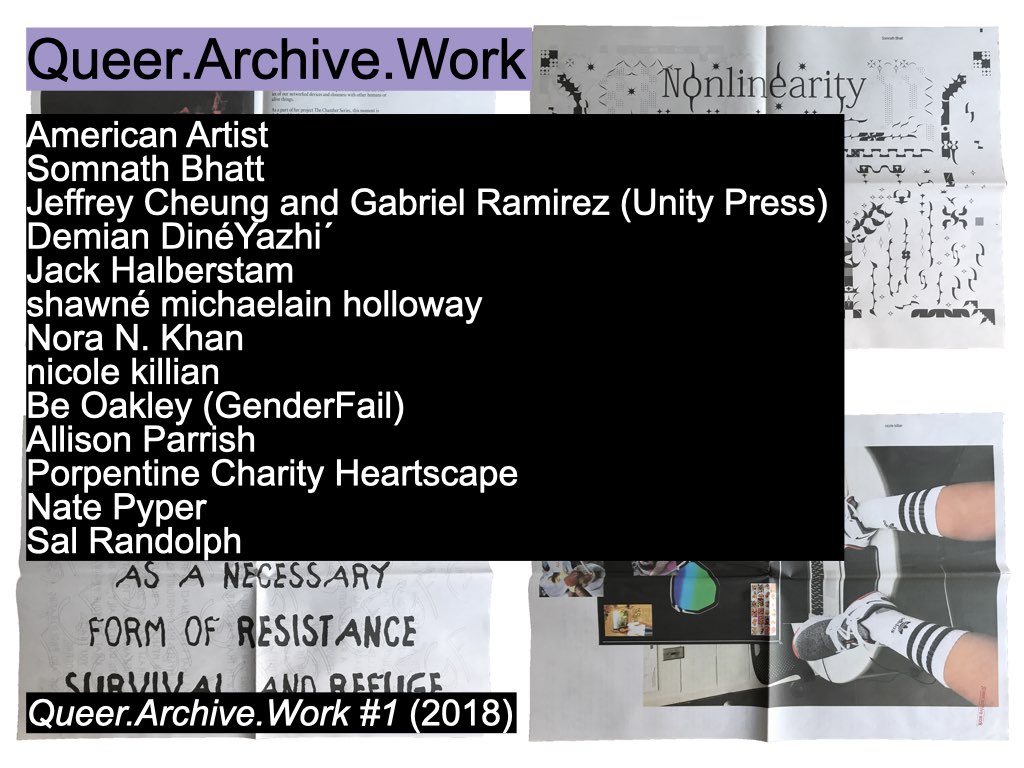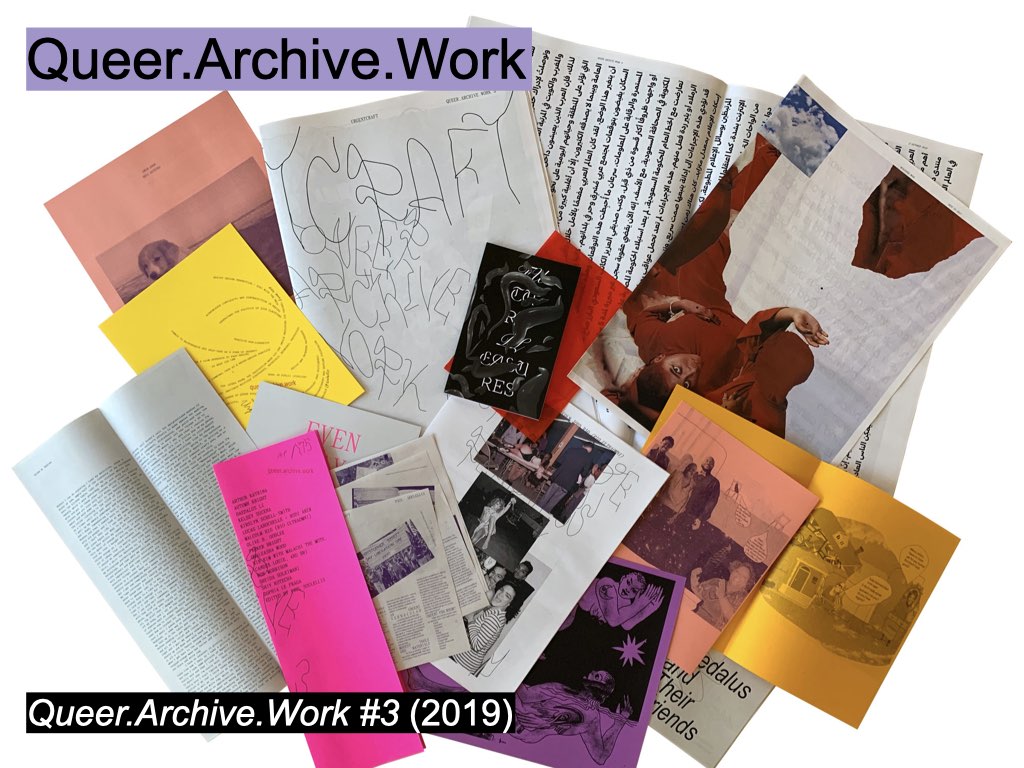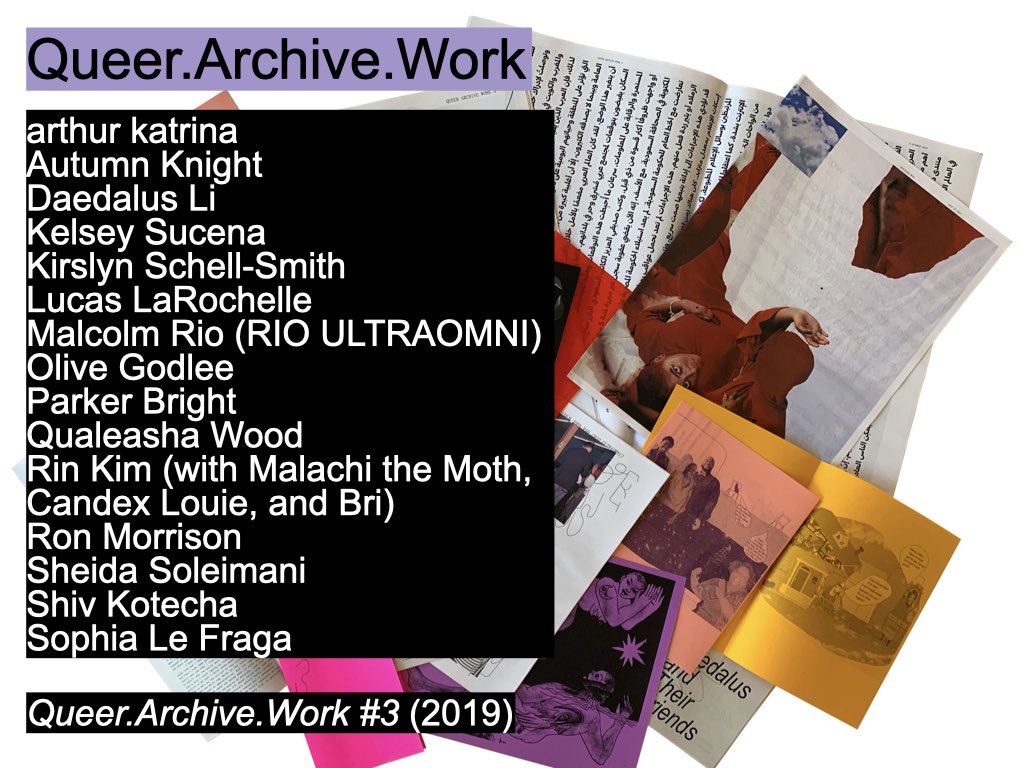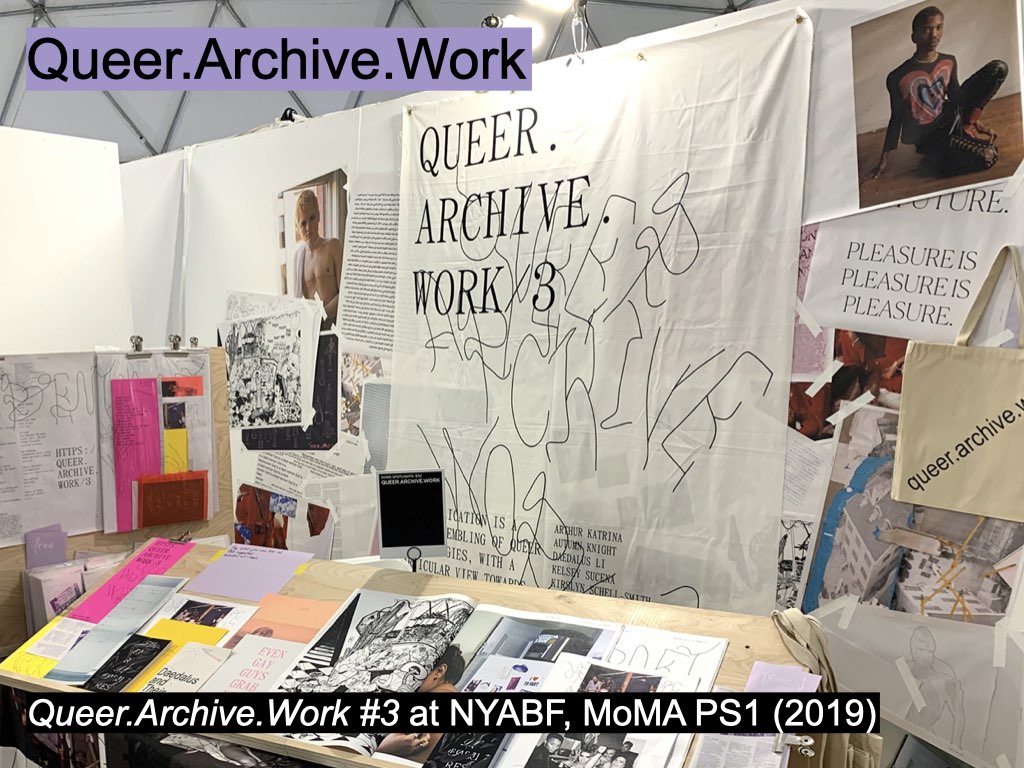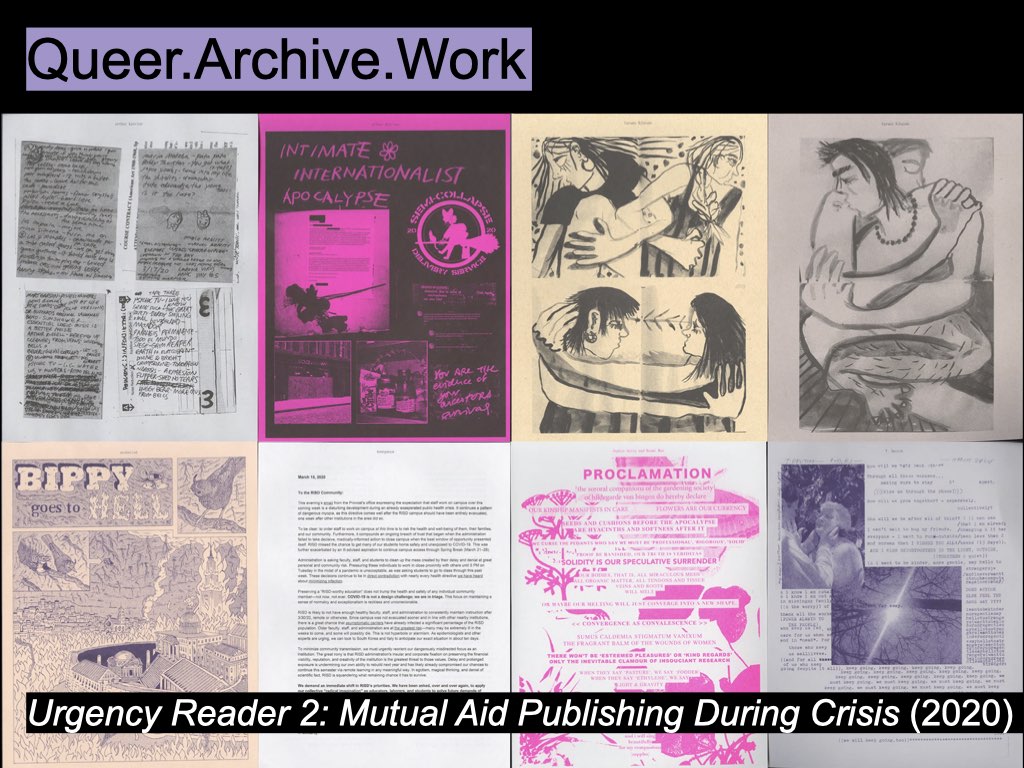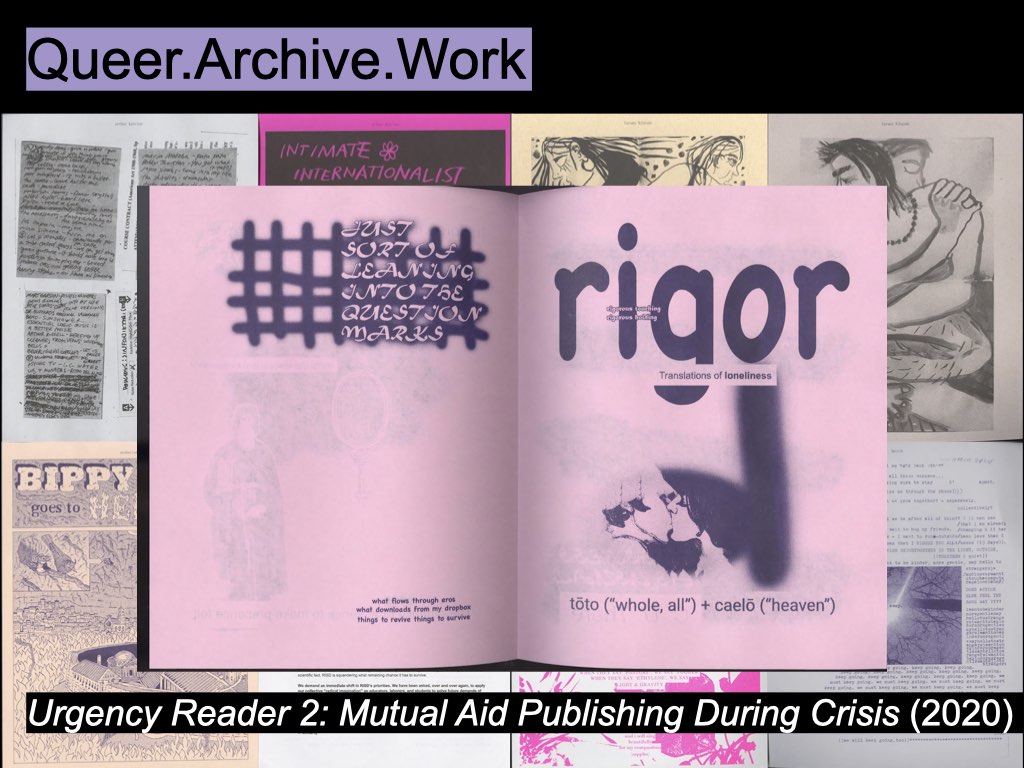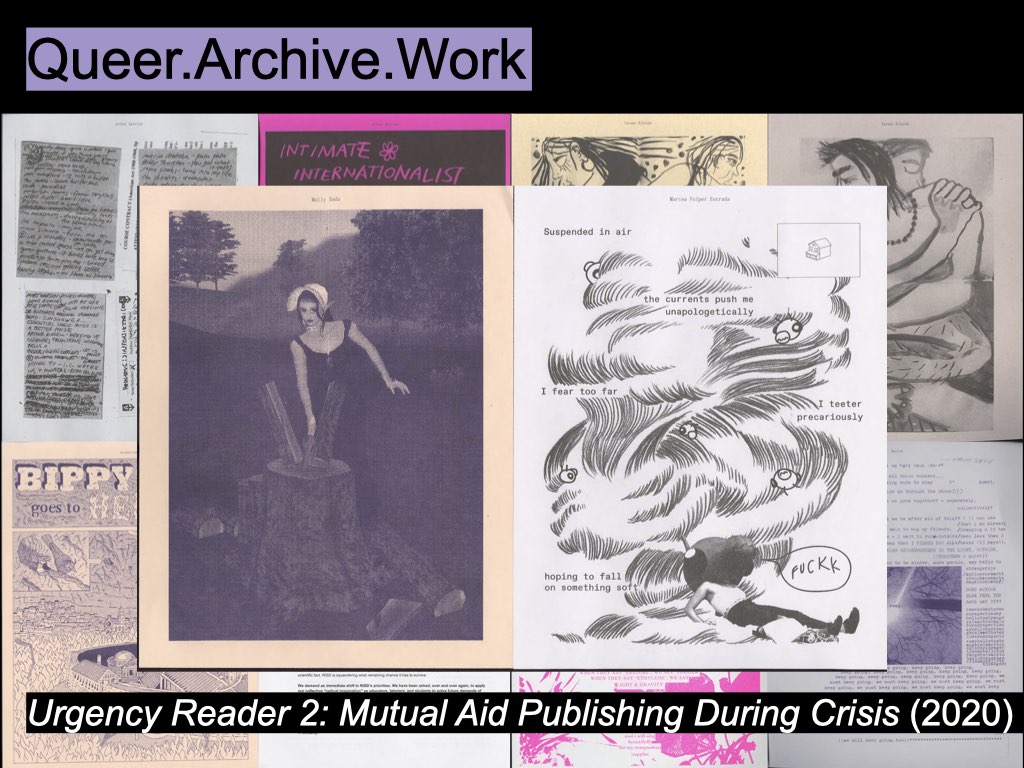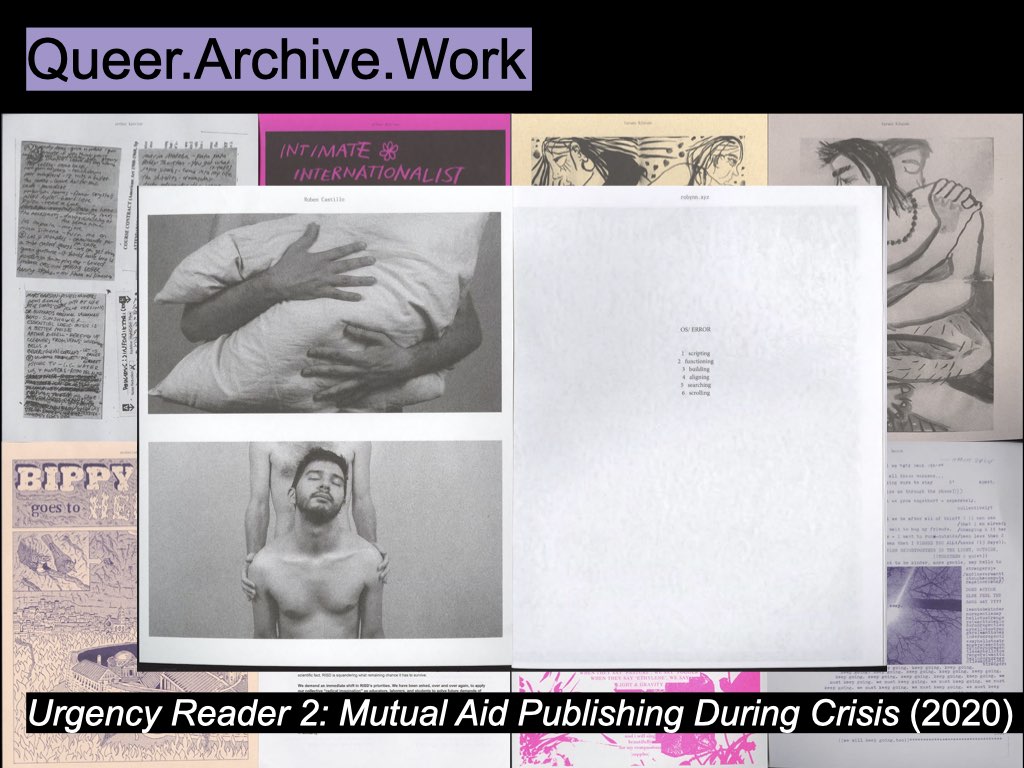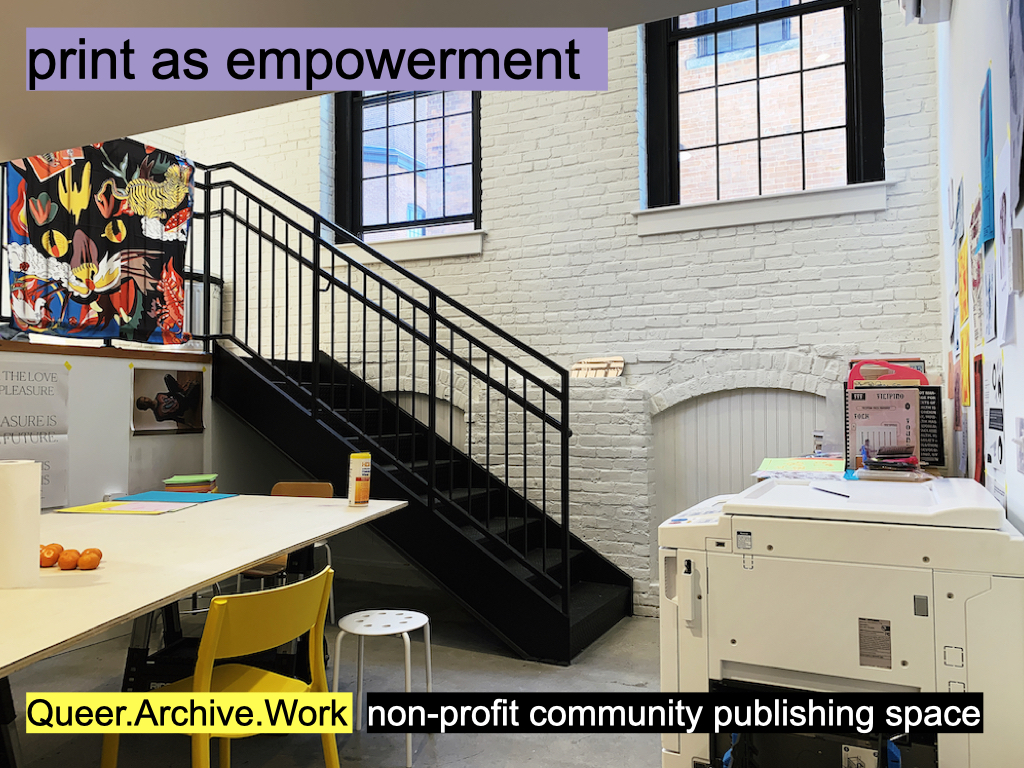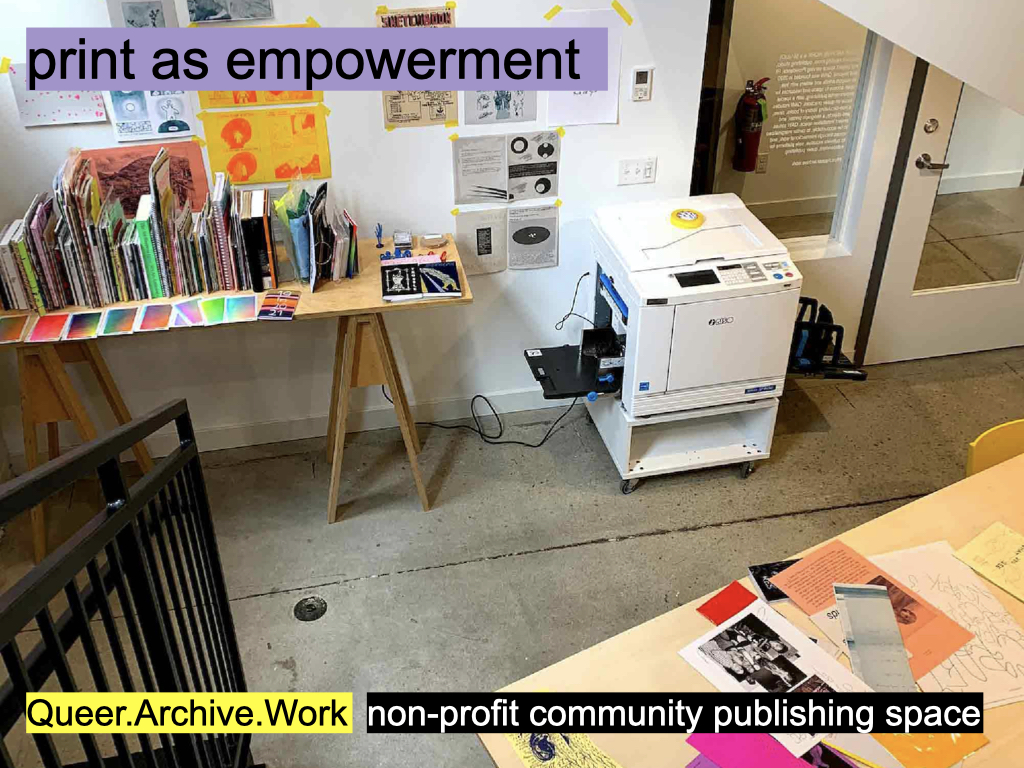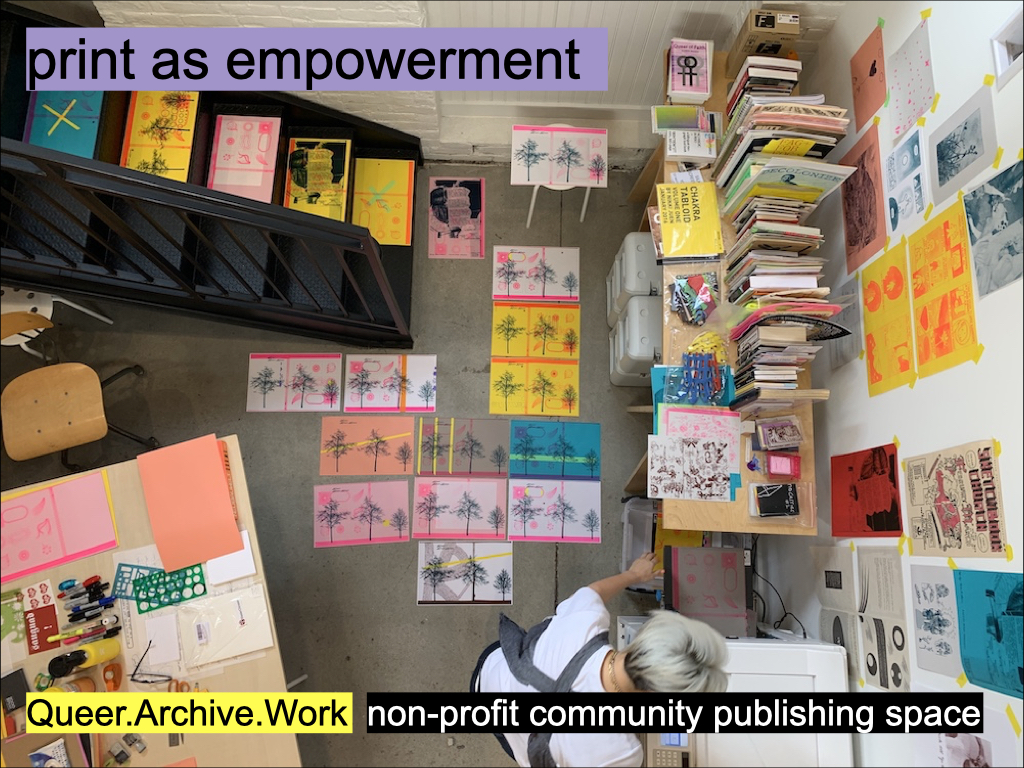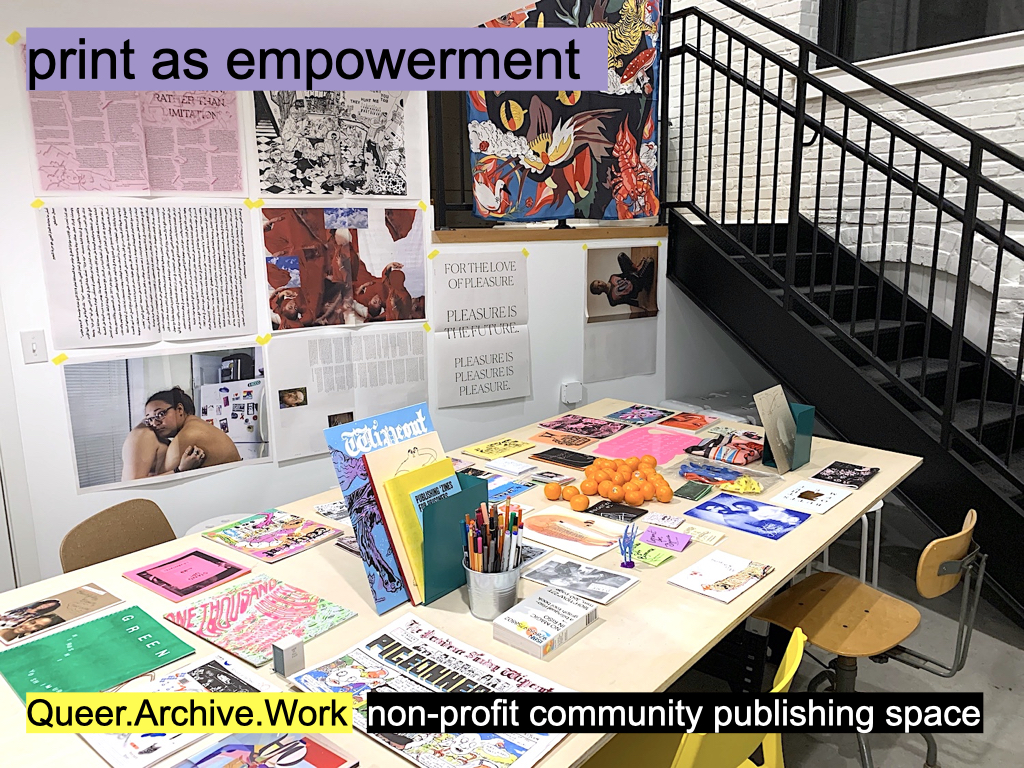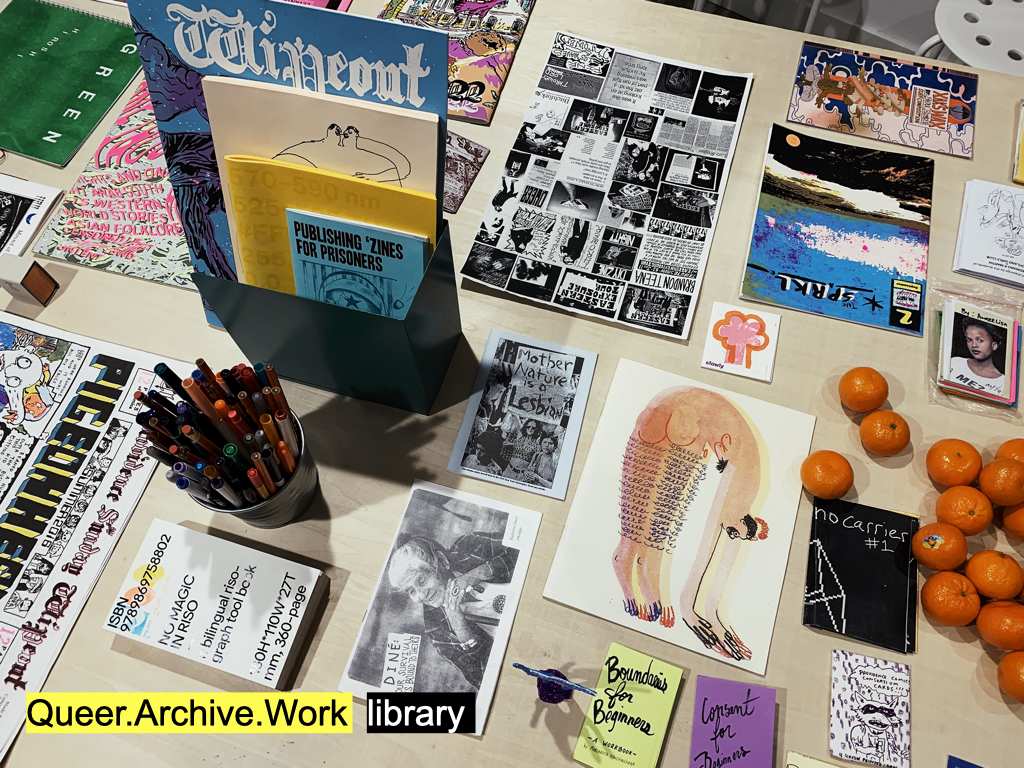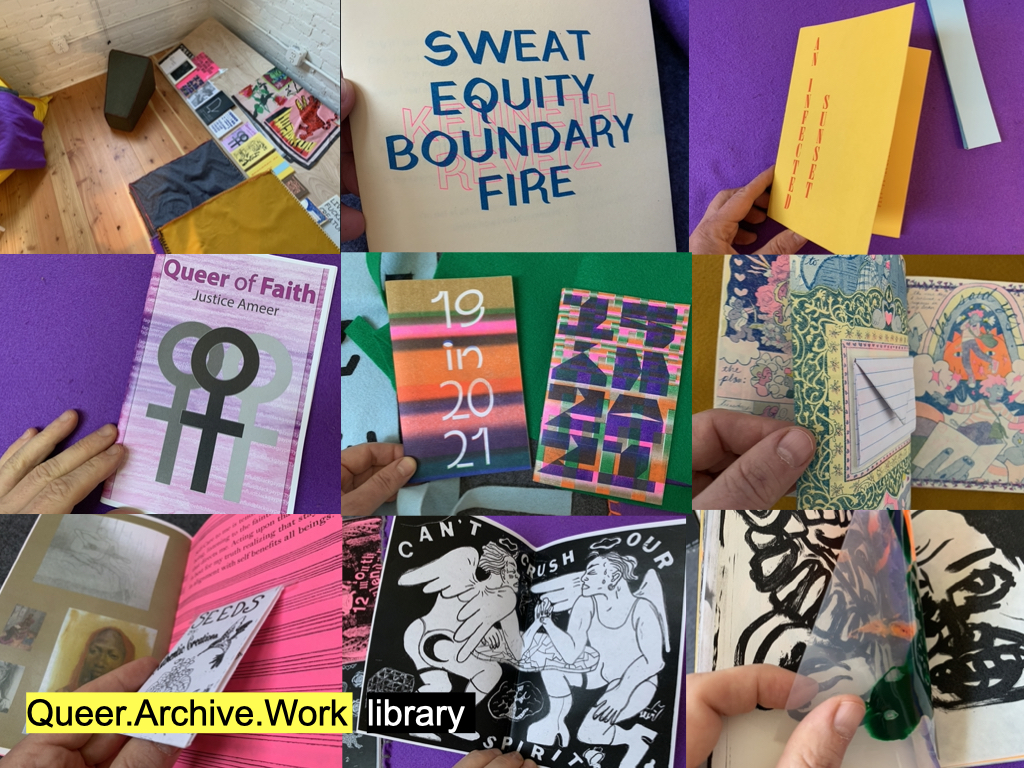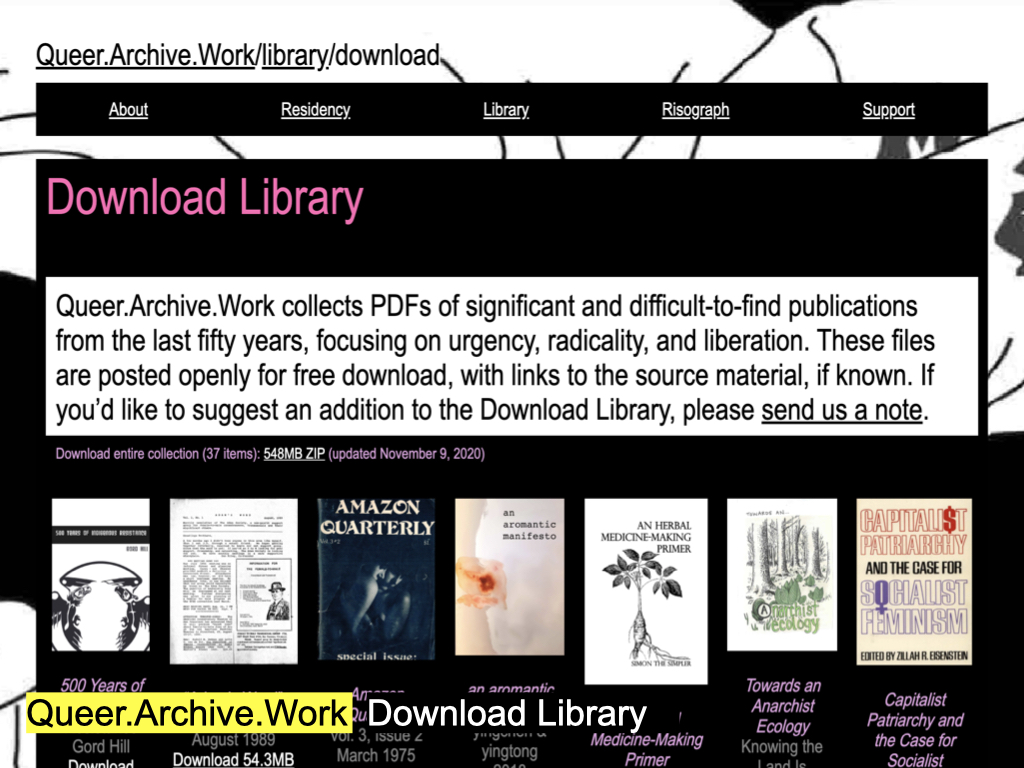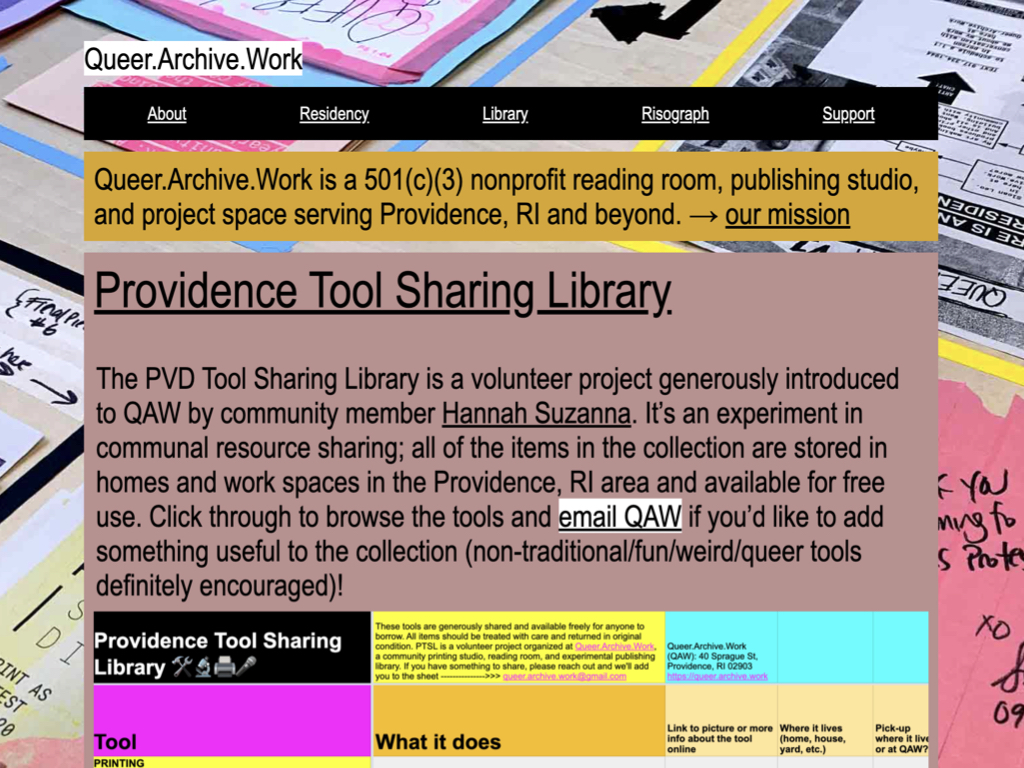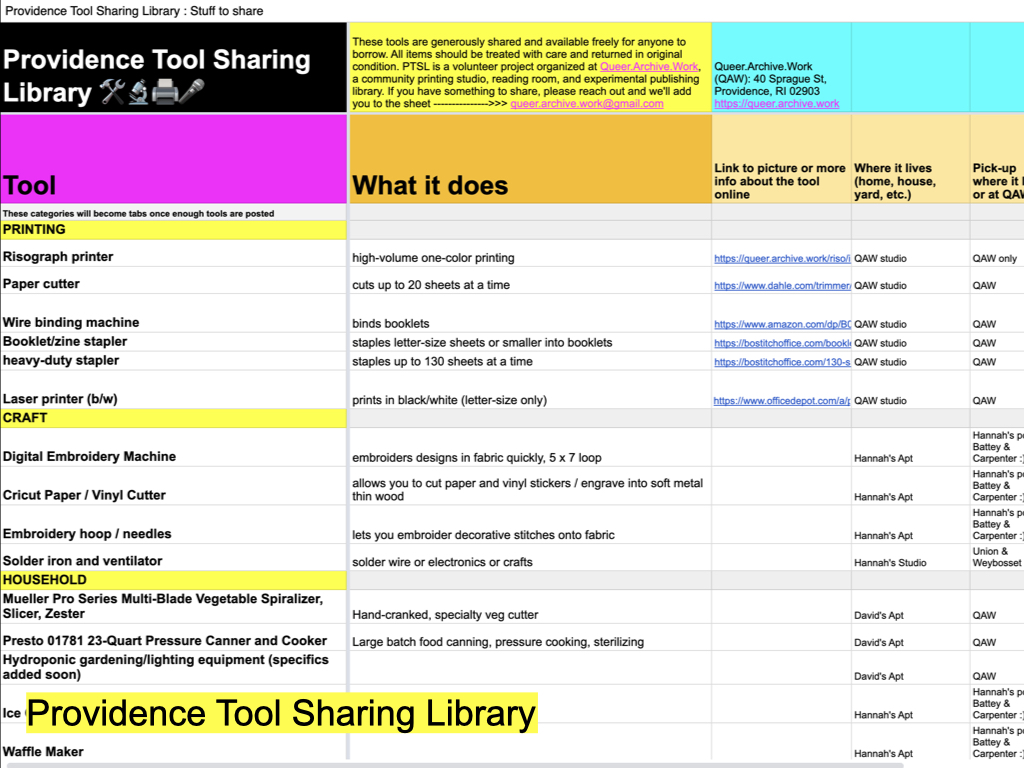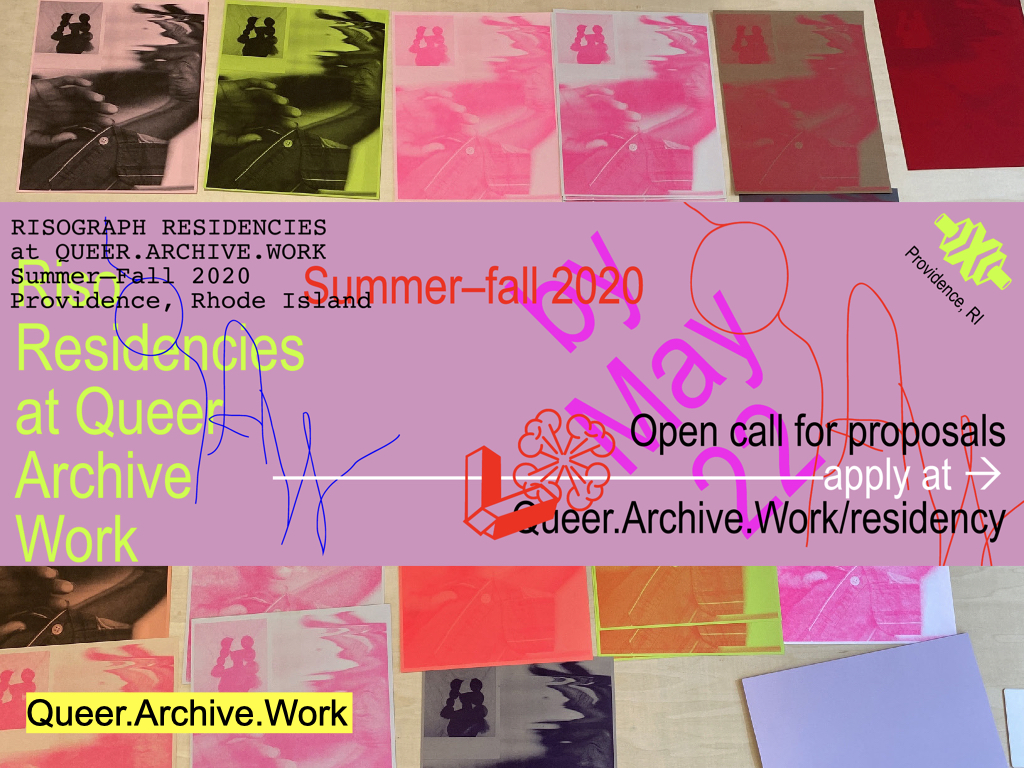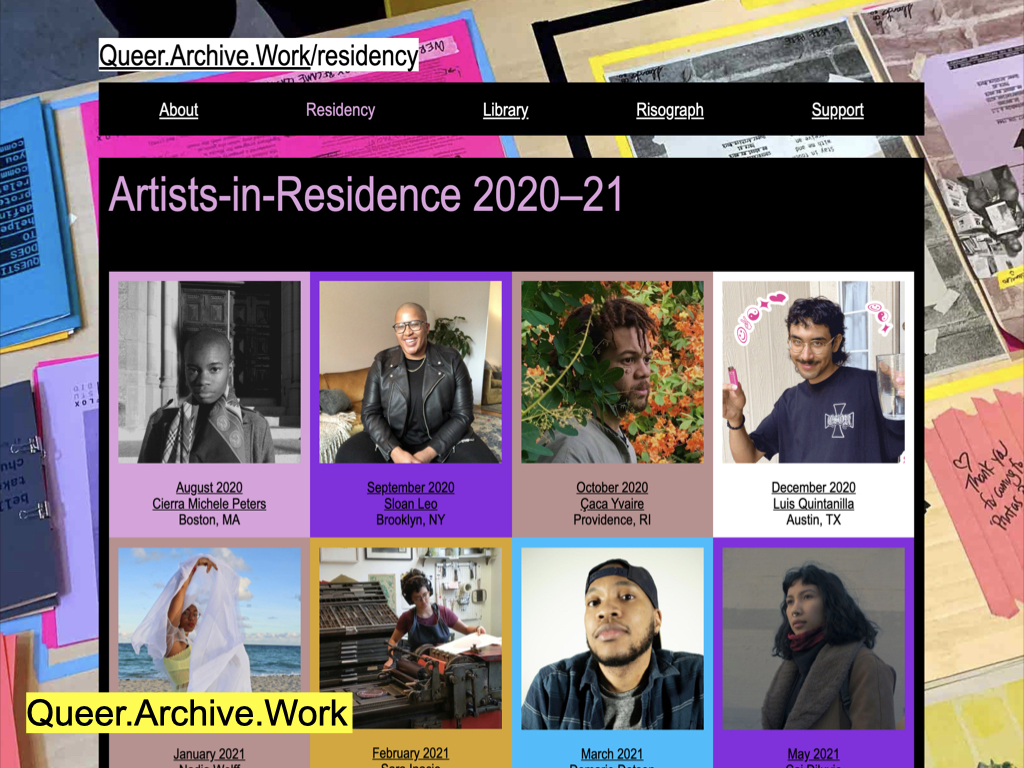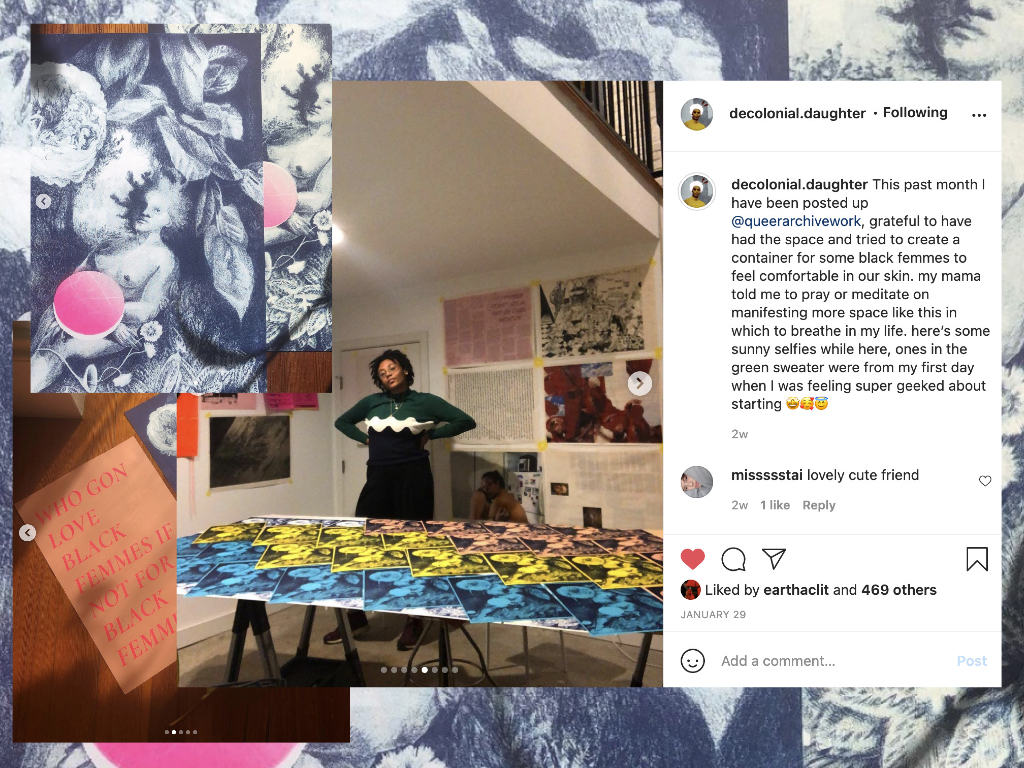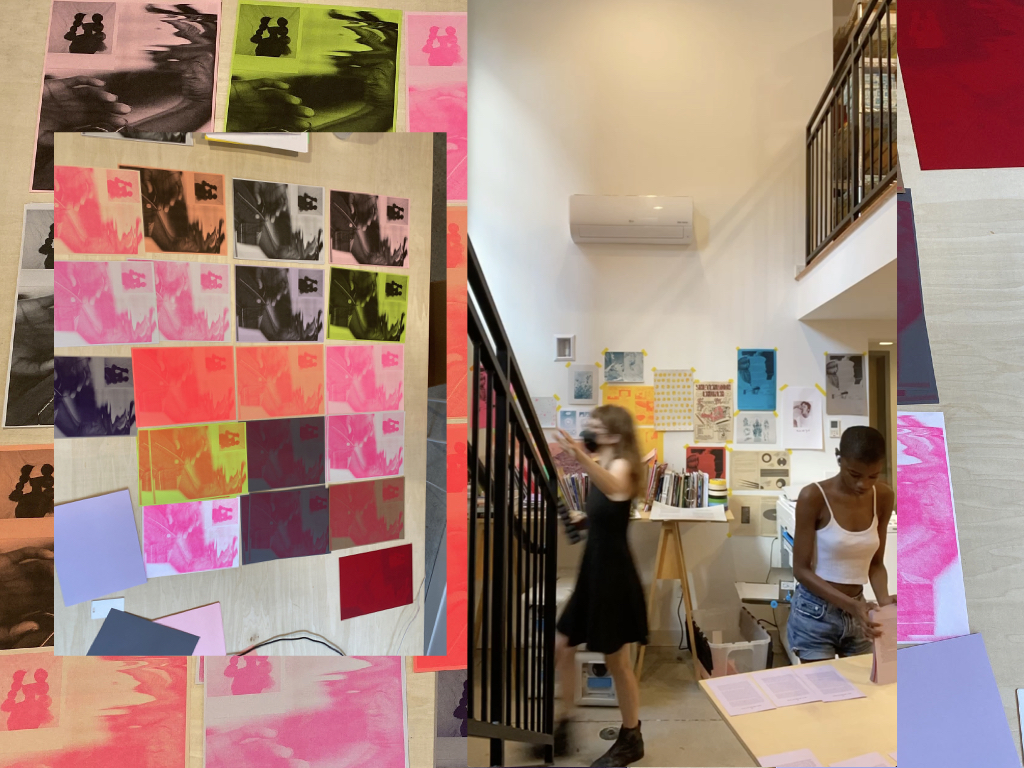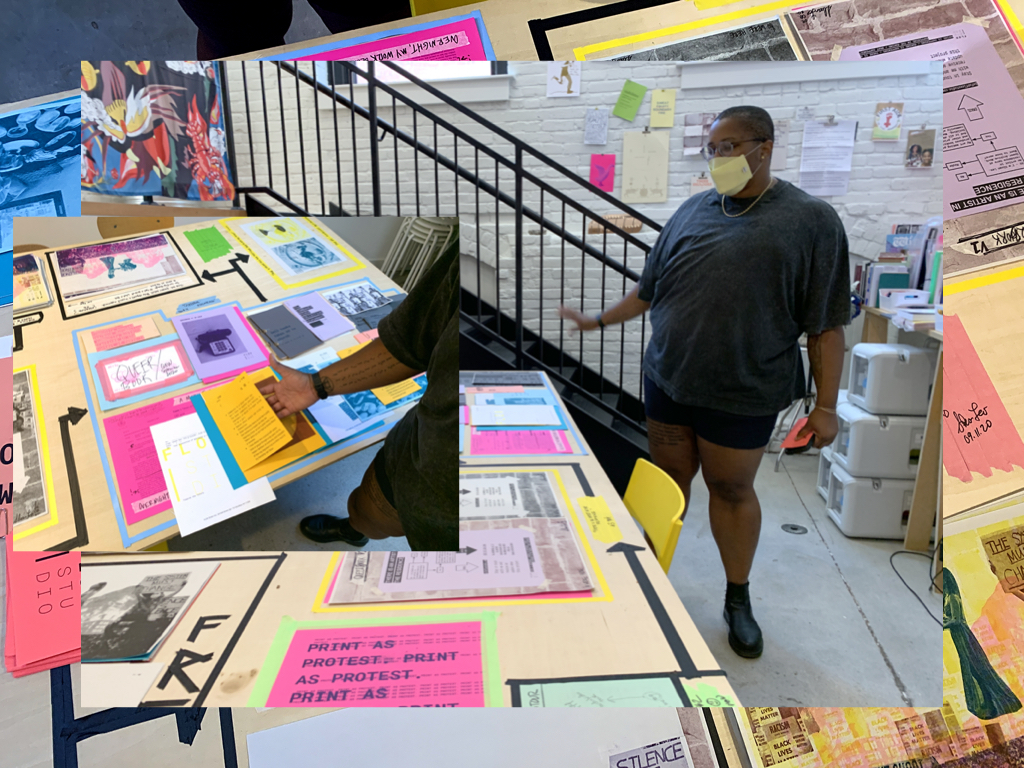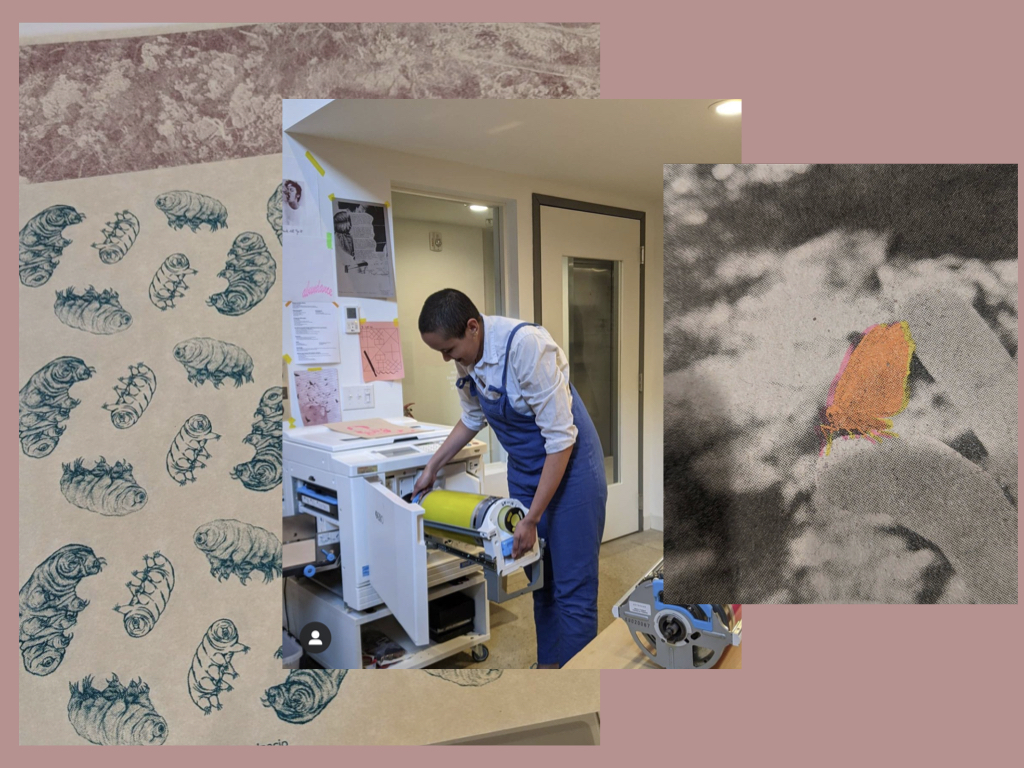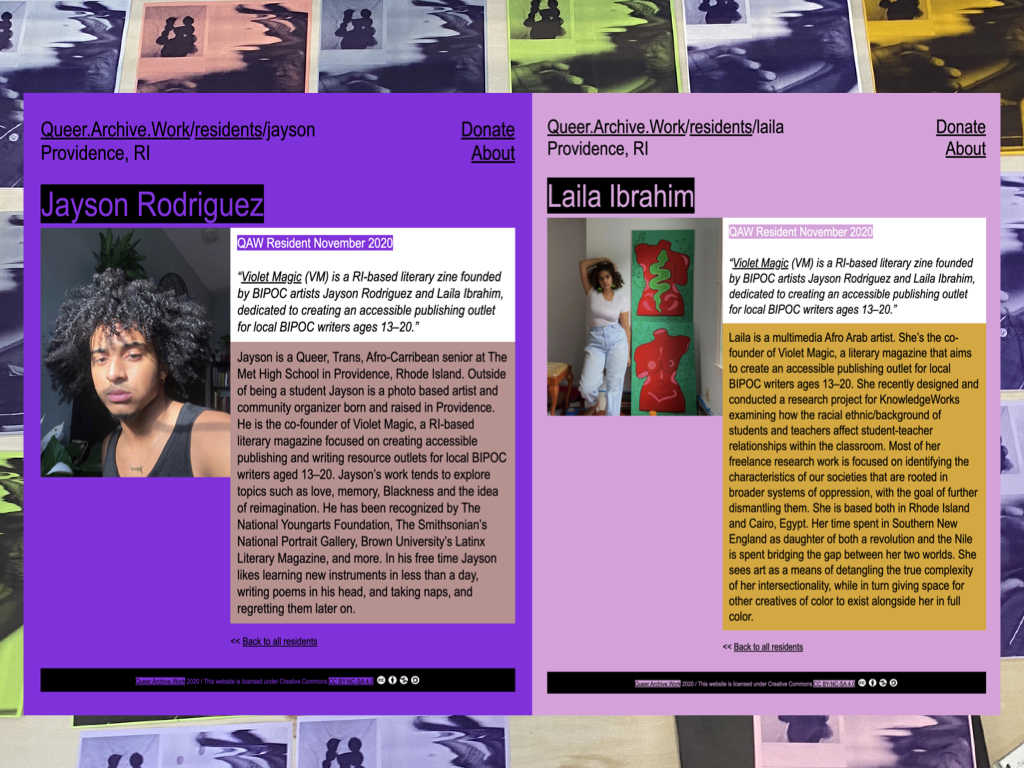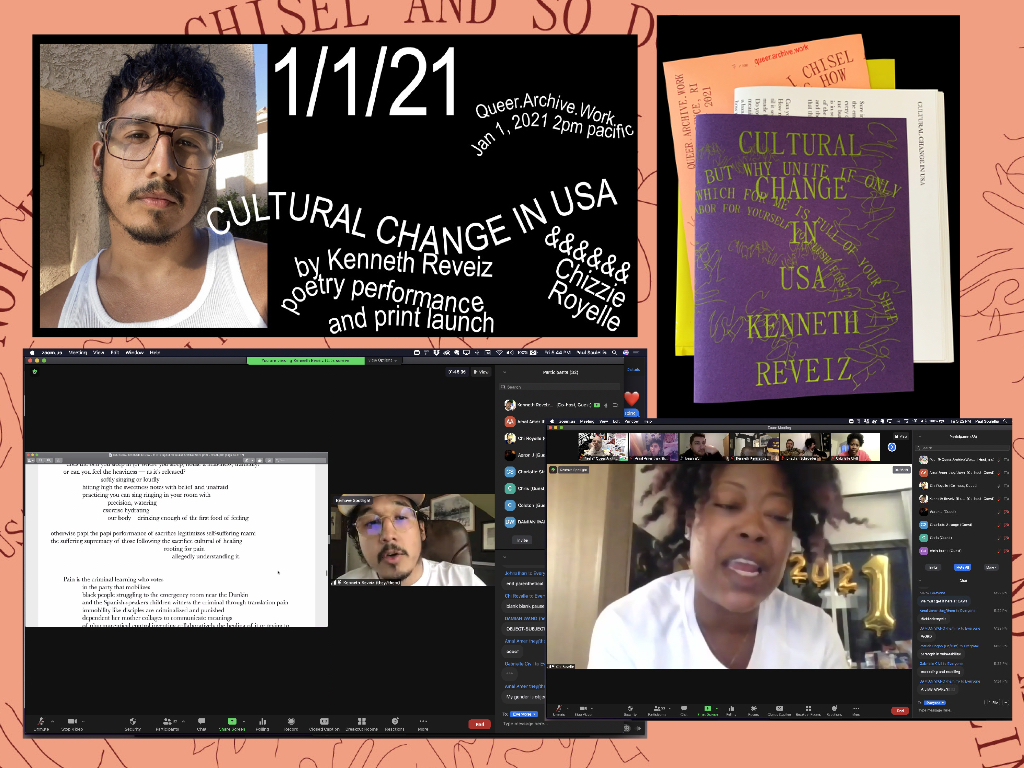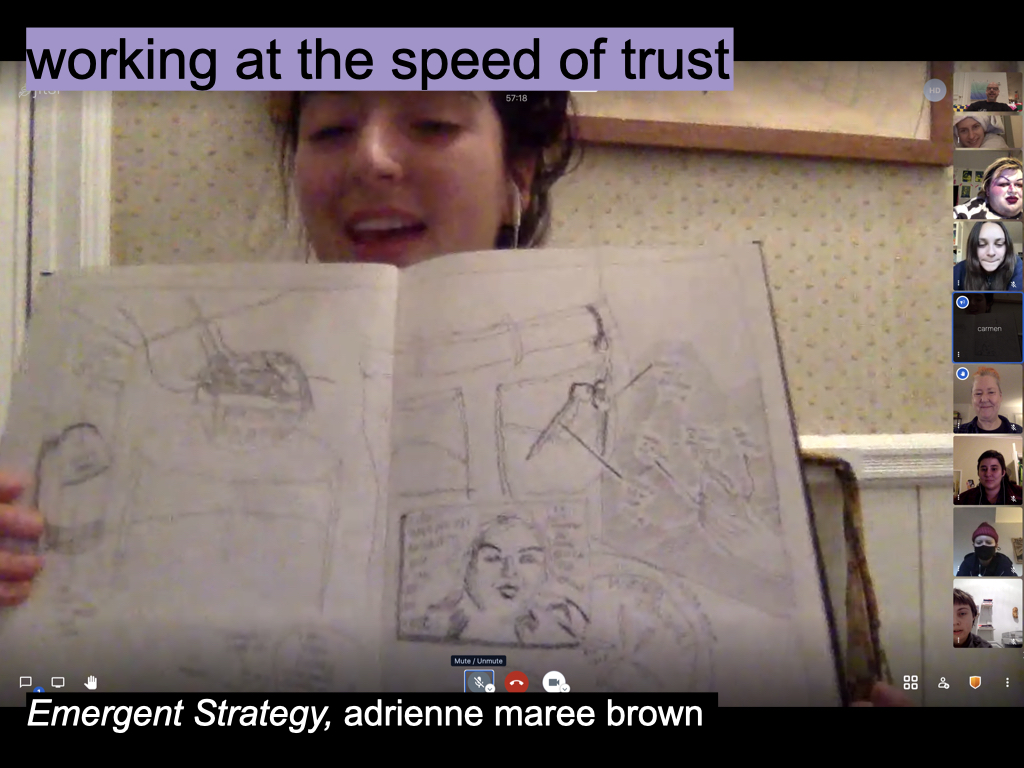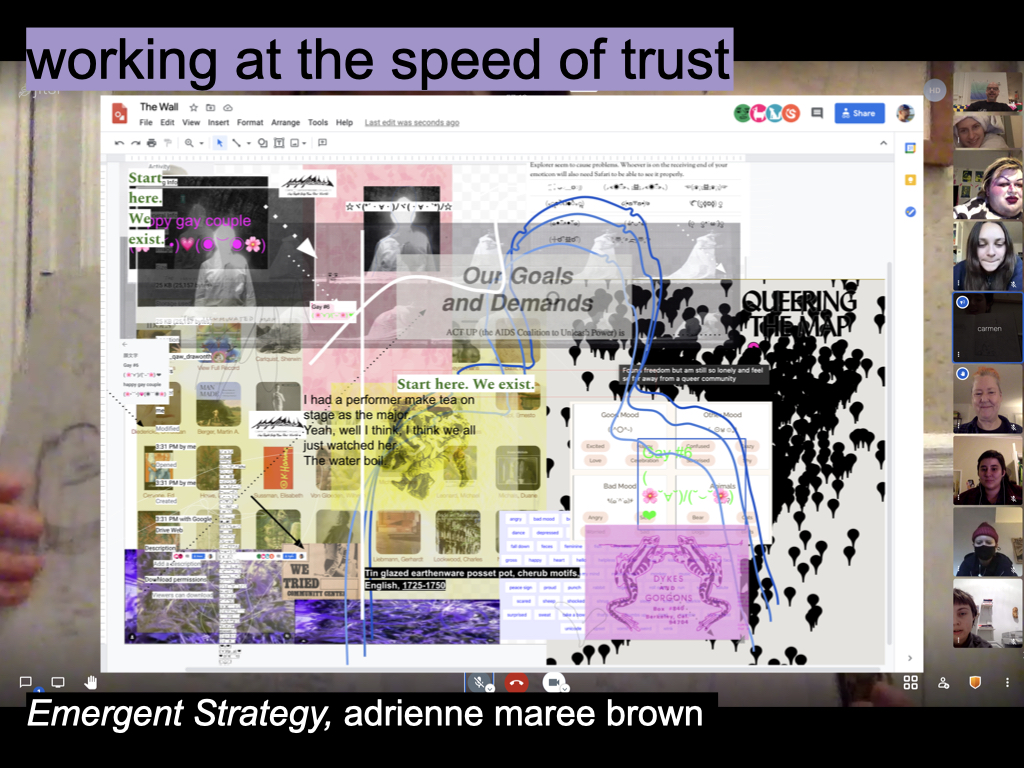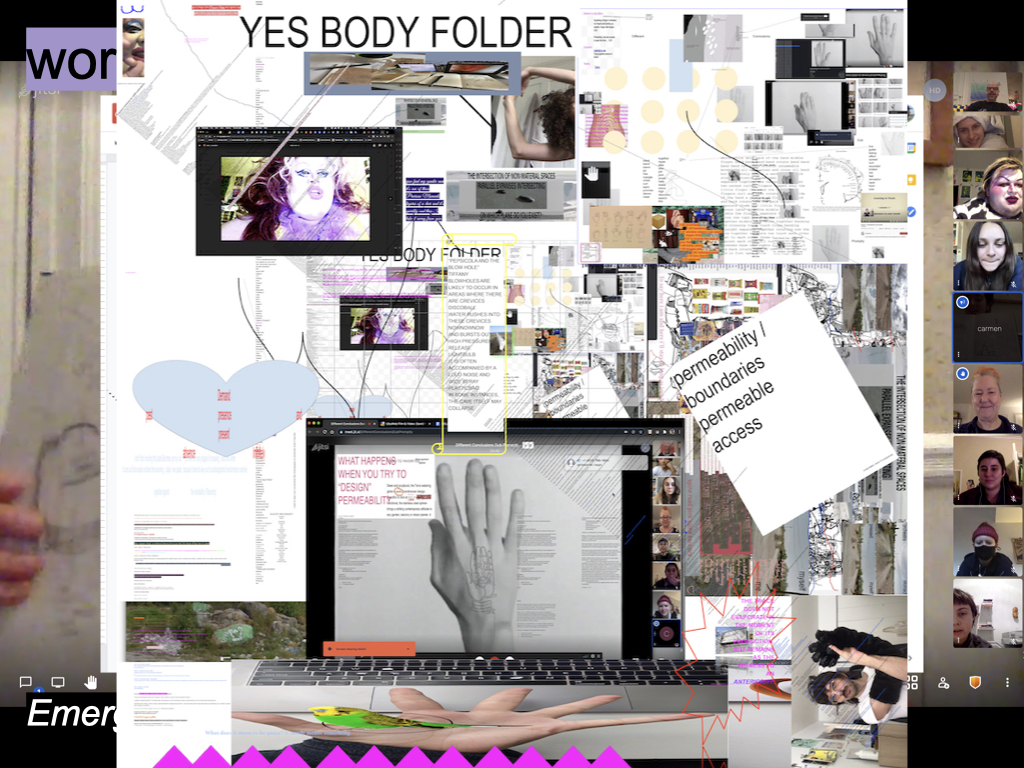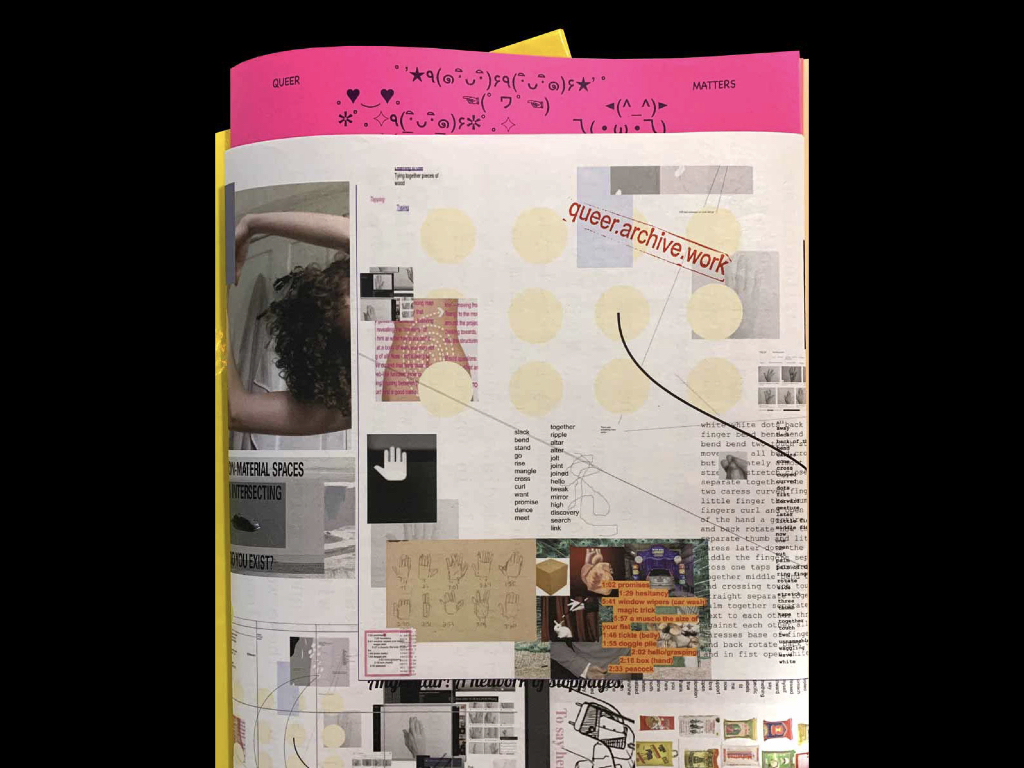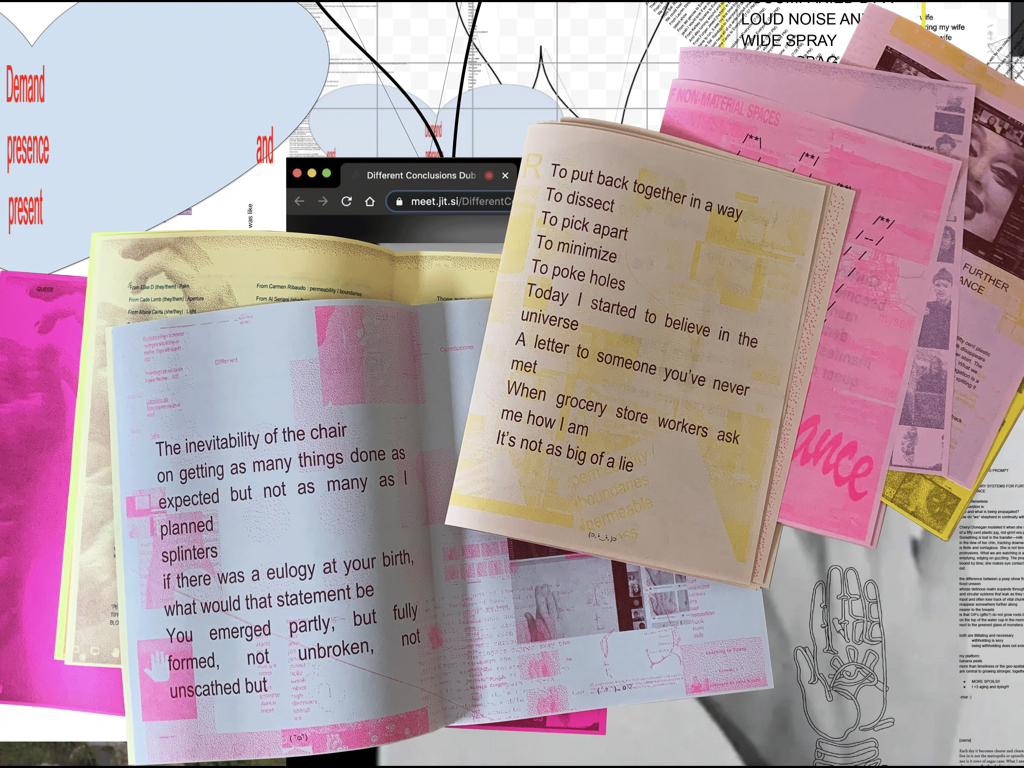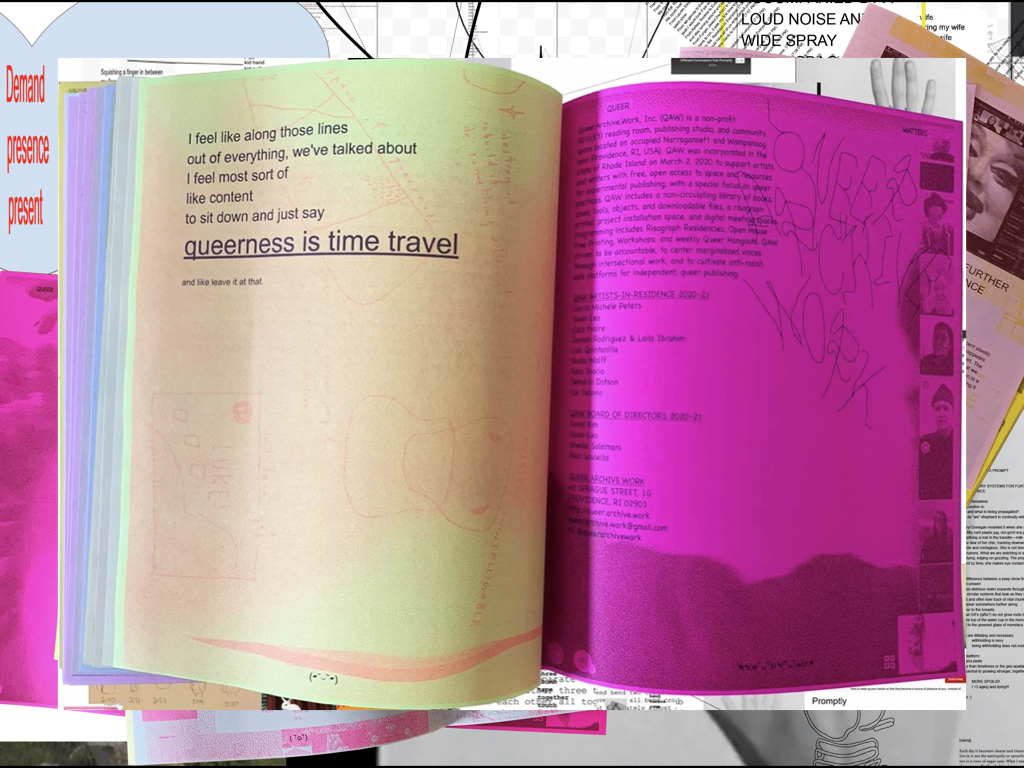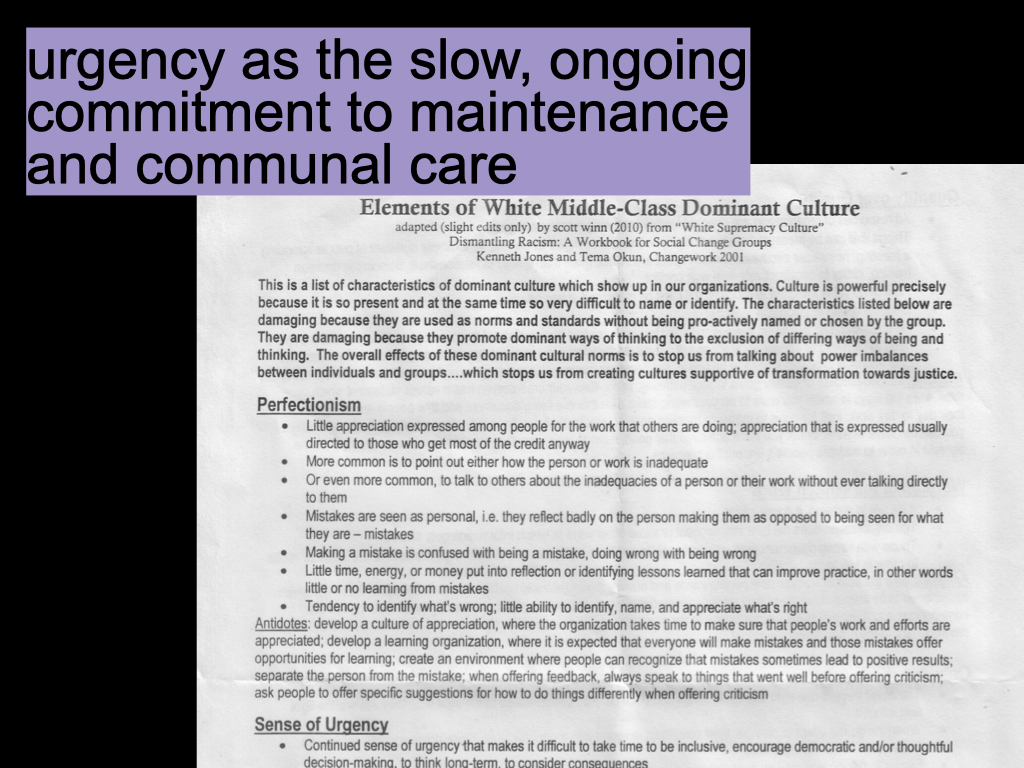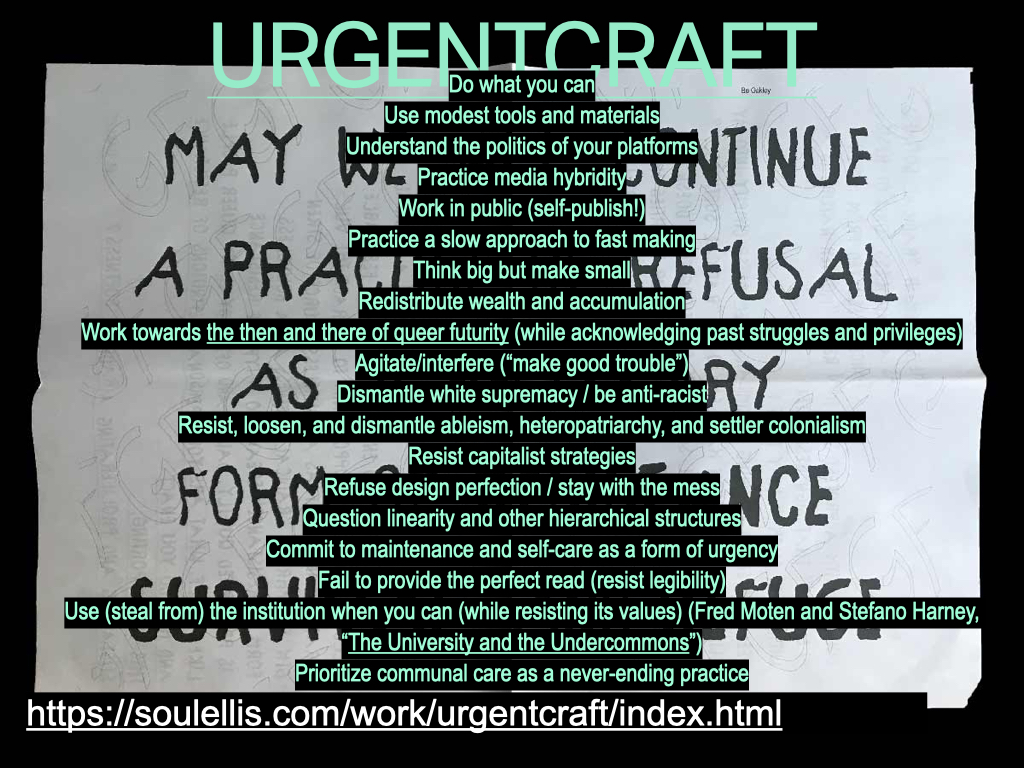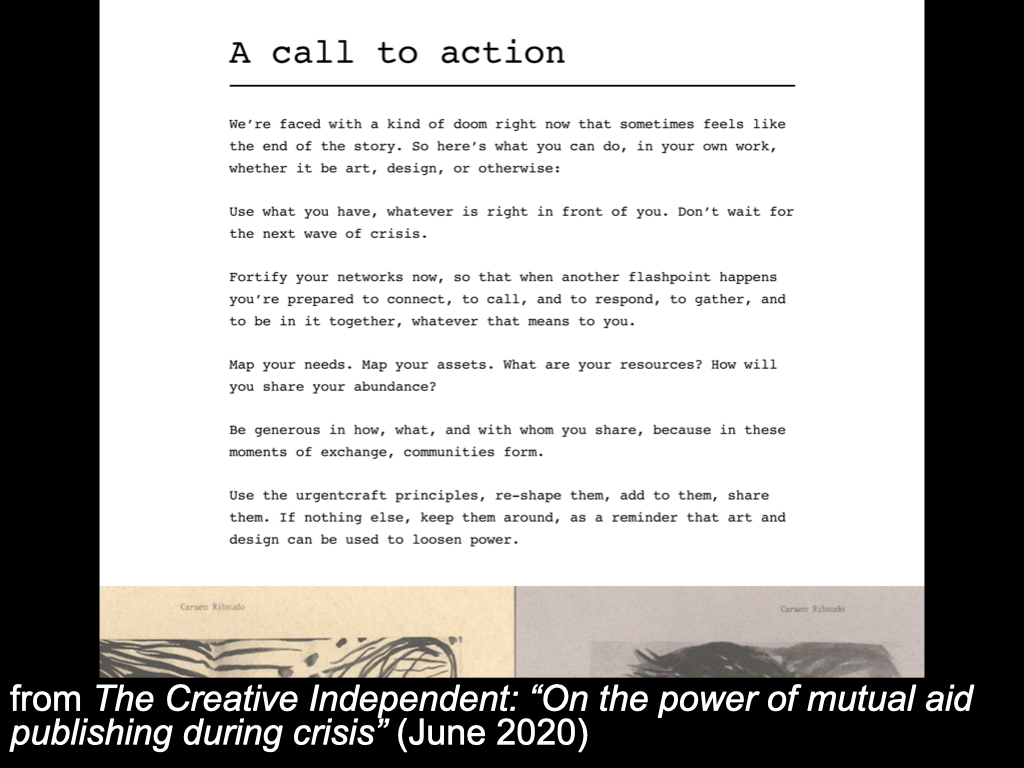1 / 144

2 / 144

This is a two-part talk. The first half is a bit more like an artist’s talk, where I’ll introduce my work and the idea of publishing as an artistic practice
3 / 144

but where we’ll end up is somewhere here, trying to get closer to this idea of urgentcraft, and how art and design can be used to loosen power.
4 / 144

Worked as a self-taught graphic designer for many years, with my own design studio in NYC. Client-based work that focused on branding, typography, and traditional corporate identity.
5 / 144

I definitely enjoyed this work and the business was able to thrive for about 15 years.
6 / 144

But after so much time accommodating the needs of clients, I reached a limit, and felt like I needed more.
7 / 144

About 10 years ago, I started asking myself new kinds of questions, like what do I need from design? What would it feel like to call myself an artist?
8 / 144

And I was able to explore these questions through the book form
9 / 144

thinking about the printed book as a container for ideas. Sounds kind of obvious now, but this was totally new for me. This is a project that I did in collaboration with the John Cage Trust.
10 / 144

And this one was for an arts festival during the London 2012 Olympics. It’s a set of 12 books about the towns of Weymouth, England and Weymouth, MA.
11 / 144

The books are like little journeys exploring perception and history and the connections and disconnects between these two places.
12 / 144

I even created a typeface that I used throughout, based on a fragment of lettering that I found in a shed in Massachusetts.
13 / 144

But this project was most significant for me because of the way I distributed the work. I made a small edition of each of the 12 volumes and actually handed them out in public space over the 12 days of the Olympics.
14 / 144

It was wild because it was so performative and durational and it tested my own stamina, but super rewarding because of how I got to meet every person who received a book.
15 / 144

And I did a few more projects like this, site-specific publishing projects that were durational and event-like.
16 / 144

This is another one I did in a small fishing village in northern Iceland, where I spent the whole summer getting to know people in the town. The population of the town was 530, so that became the name of the project, and the number of pages in the book.
17 / 144

These were really intense, relational projects, because they involved spending time in these places and embedding myself in these communities.
18 / 144

At the end of this one I printed just 50 copies in Reykjavík, and left most of them in the village with people who appear in the book, but I also hid a few around Iceland.
19 / 144

I did one more project like this in England, on the Isle of Portland. These projects were exhausting and extremely difficult, because of the emotional depth required for them to be meaningful. At the end of this one I said ok, that’s it, no more.
20 / 144

It’s around this time that I started teaching at RISD. I was also getting to know a number of artists who were working with the internet, but experimenting with print—seeing what happens when we slow the internet down by printing it out
21 / 144

and this very quickly turned into another kind of project, a curatorial one. I started collecting artists’ books and ephemera made by artists who were printing the internet in different ways, and I called this “Library of the Printed Web.”
22 / 144

Library of the Printed Web became a way to ask questions about materiality, about speed in relation to reading, and how network culture was shifting, especially now that the internet was ubiquitous, with the introduction of the iPhone in 2007.
23 / 144

And this also became a publishing project—a way to introduce new work by some of these artists.
24 / 144

Library of the Printed Web was a lot of fun, getting to publish this work and writing about it and exhibiting it, and the project received a lot of attention.
25 / 144

In the end I produced about 20 publications through Library of the Printed Web, and starting thinking about this as “publishing as artistic practice.” And then in 2017 the entire project was acquired by MoMA Library.
26 / 144

That was a satisfying moment, the collection of about 250 works going to MoMA, the ultimate archive.
28 / 144

and step back from my own work a bit, and ask some larger questions about these terms. When we talk about publishing as artistic practice, what do we mean?
29 / 144

I like to think about it in terms of making public, that publishing at its very essence is about putting something in public.
30 / 144

It’s this image of a community bulletin board that I love to come back to as the most basic example of making public. But is this publishing? I’d say that it is—selecting something to amplify, and posting it in public to give it an audience.
31 / 144

But then what about this? Is this publishing? It’s certainly making public, but less about posting and more about performing for a very specific public. Addressivity. Perhaps not everyone is included here but just those who have gathered to listen, so that asks us to look closely at what we mean by public. Who’s listening?
32 / 144

Is this an act of publishing? This kind of making public interests me deeply, and we’ll return to this image in a minute,
33 / 144

as does this, newer forms of making public that are very much about durational performance. I love stretching the idea of publishing into these slippery places
34 / 144

and here, a form that’s super familiar to us now. Platforms that have become places for us to publish on a daily basis, almost without thinking.
35 / 144

And of course this, the ordinary table at an art book fair, which allows an artist to be on one side and the public to be on the other. Direct engagement over the published material, in physical space.
36 / 144

But these aren’t my ideas—I’m borrowing them from social theorist Michael Warner, who wrote about publics in this text “Publics and Counterpublics,” that I come back to again and again, because it’s pretty dense, so when I teach it I usually re-read it with students to try to get a little bit further with it
37 / 144

In this text Warner makes distinctions between the public, or “everyone out there,” vs. a very specific public, say those particular people who have gathered intentionally around something. And so he gives us the notion of a plurality of publics. Multiple publics.
38 / 144

Warner says that to publish is not just to “make public,” but to make a public through the circulation of material. A public gathers around the work and generates discourse, and only then has a public formed.
39 / 144

So, previously we may have thought about publishing as the production of objects: things that you make, like books and zines.
40 / 144

Warner turned this around for me. Publishing is less about those objects you make, and more about the actions you take. How those objects circulate. Your publics form around this action, through the dispersion of material.
41 / 144

So we can talk about publishing as an act,
42 / 144

or as the gesture of publishing. What are the gestures of publishing? We’ll get back to that in a minute.
43 / 144

Publishing as performance.
44 / 144

That’s why I’m so intrigued by artistic publishing that takes this form now, things like live streaming as an act of publishing
45 / 144

or the publishing of digital files that are meant to be downloaded, like this series called The Download that I curated at Rhizome for a few years, where artists created works that were entirely contained within ZIP files.
46 / 144
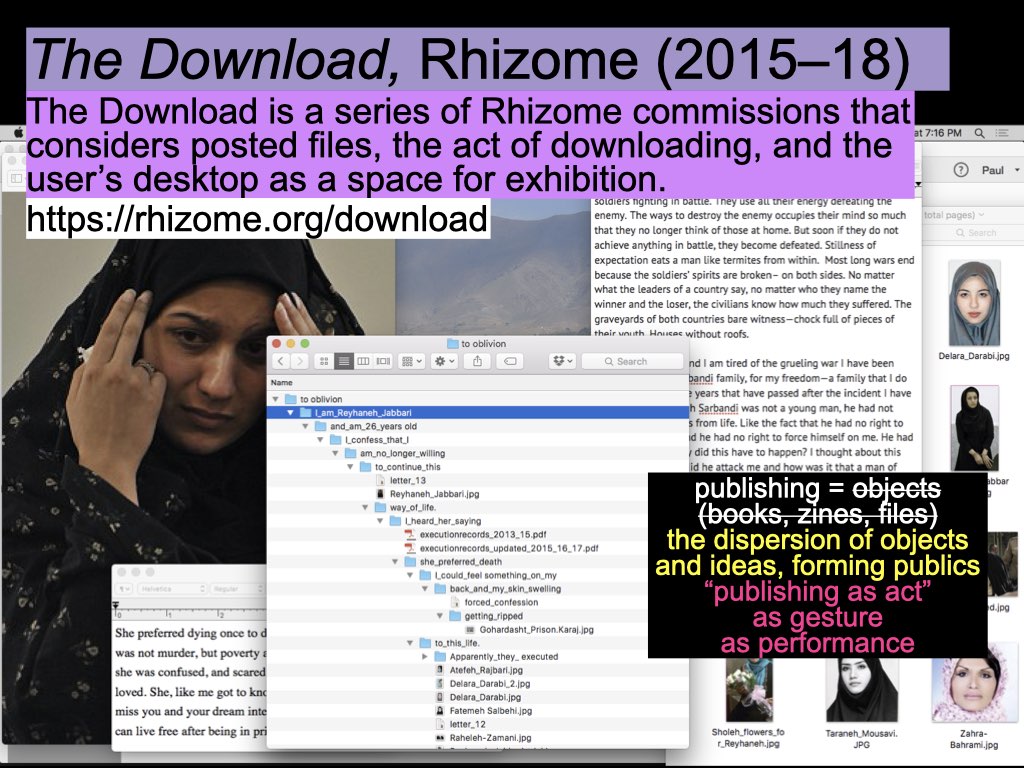
The act of publishing is located right there in the uploading and downloading of the files, the private performance of these files on the viewers’ desktops, and the circulation of these files on the internet. It’s all about movement.
47 / 144
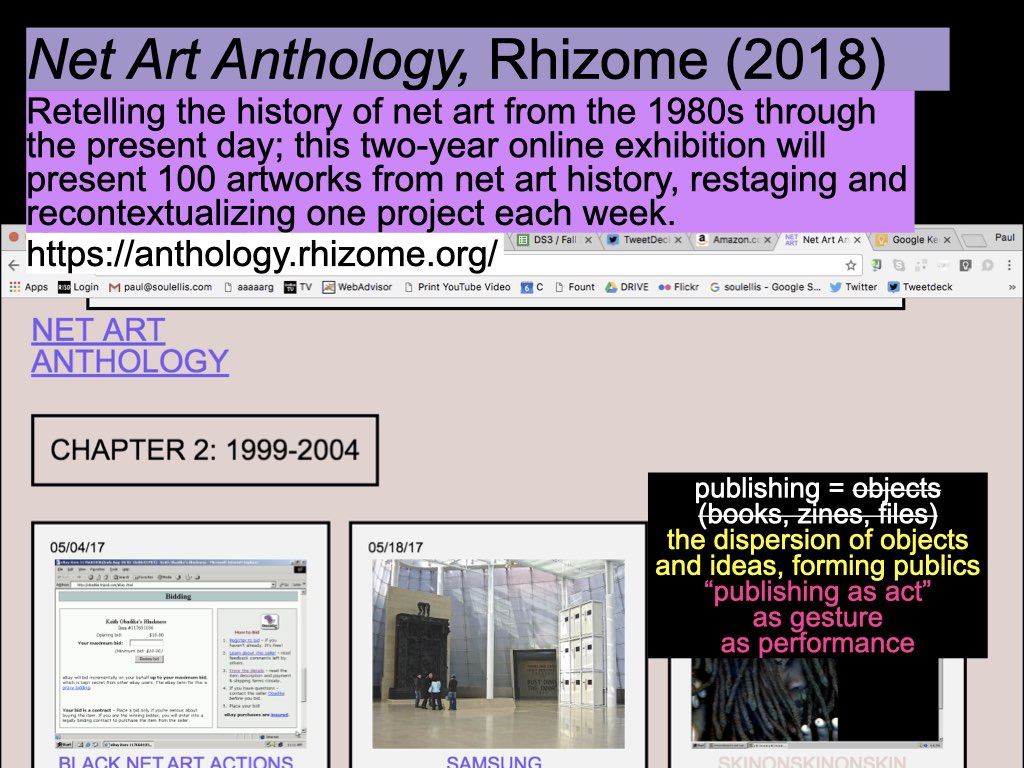
There’s a whole world of net art that looks at publishing in this way, in the realm of digital files and networks, and for Rhizome’s Net Art Anthology I was able to do some writing that’s become really central for me,
48 / 144
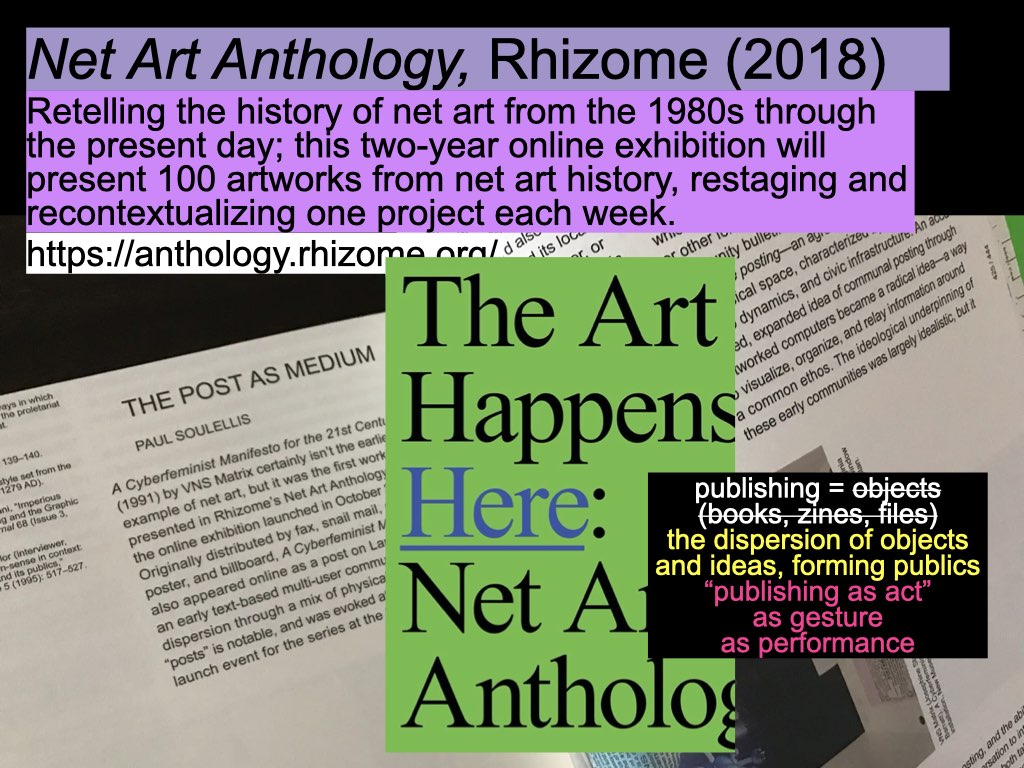
published in this beautiful book, a huge catalog of net art, where I wrote about the post as an essential act of publishing.
49 / 144

Posting as a gesture of publishing. In the sense of posting a photo or making a blog post, or posting a tweet, but also going into the history of this word post, which I’ve never really been able to find much about.
50 / 144

I’ve tried to trace the word back through time by looking at other words that contain the gesture of posting, like “poster”—the most basic act of putting something up on a vertical surface in public space. This goes back thousands of years, perhaps tens of thousands of years, making marks on walls, so I think it’s a foundational gesture.
51 / 144

But do you ever wonder about language like “keep me posted,” or the post office, or the daily post? This is more legend than scholarly research, but it seems as though this language might be traced back to the figure of the town crier, who would announce the news at the center of town, to people who were probably not literate, or who didn’t have access to books. When the town crier was finished reading the news, he would nail it to a door post at the center of town, and so—the news was posted.
52 / 144
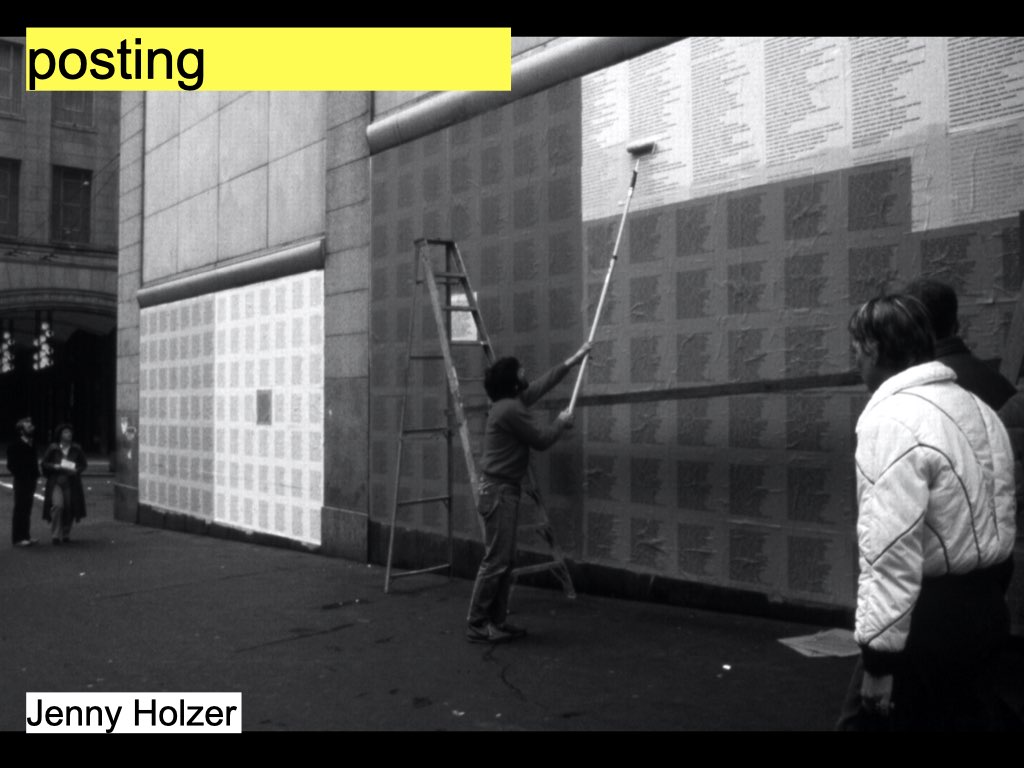
There’s a whole history of artists who have used this very basic gesture of posting in public to great effect, from Jenny Holzer’s Truisms in the 70s,
53 / 144
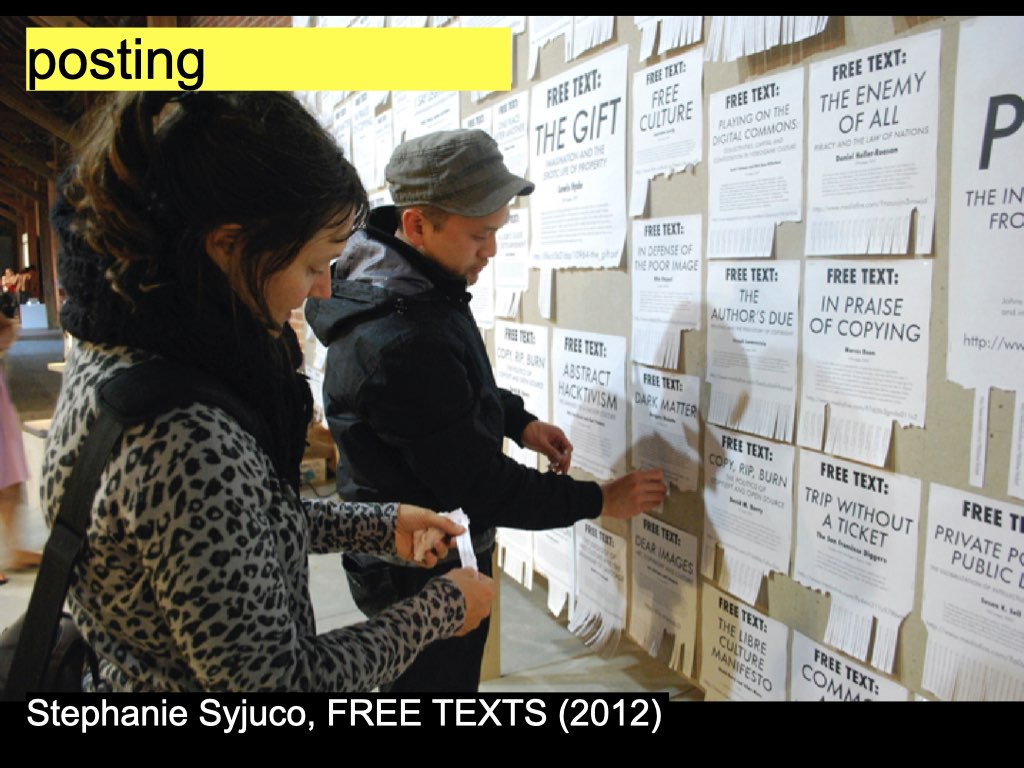
to Stephanie Syjuco’s use of the casual flier to distribute URLs for downloading free PDFs,
54 / 144
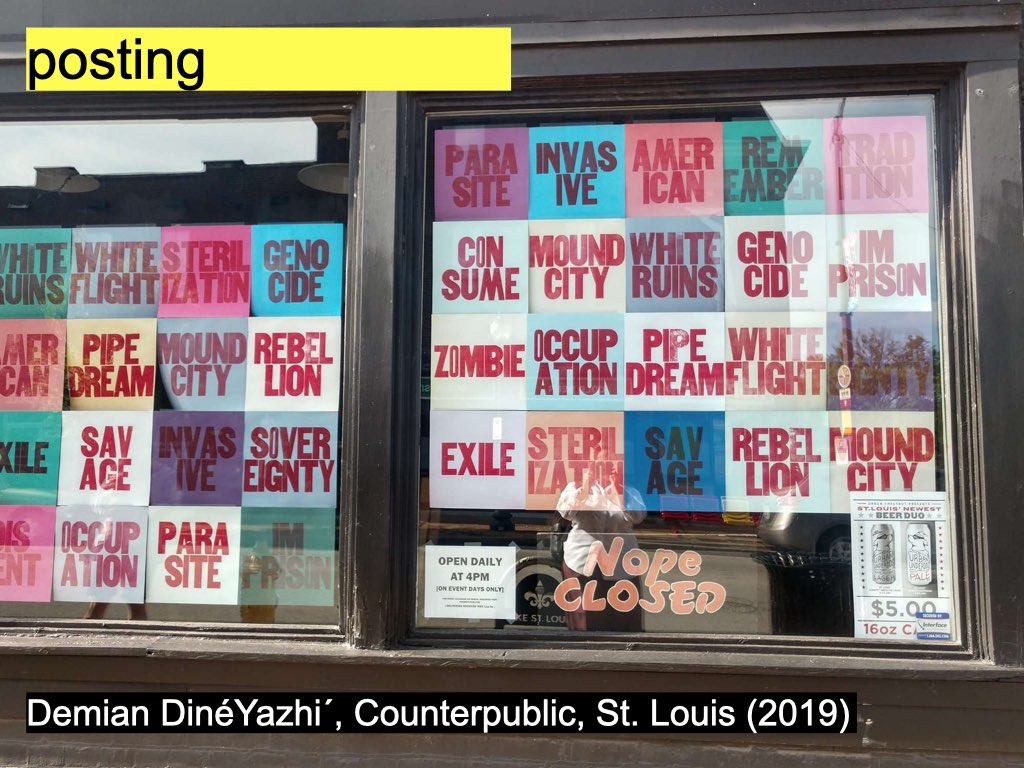
to Demian DinéYazhi´ who letterpressed these words and put them up in a window across the street from a controversial statue in St. Louis, Missouri,
55 / 144

and Alexandra Bell’s Counternarratives series, which posts annotated artifacts in public space to reframe how we write more just histories.
57 / 144
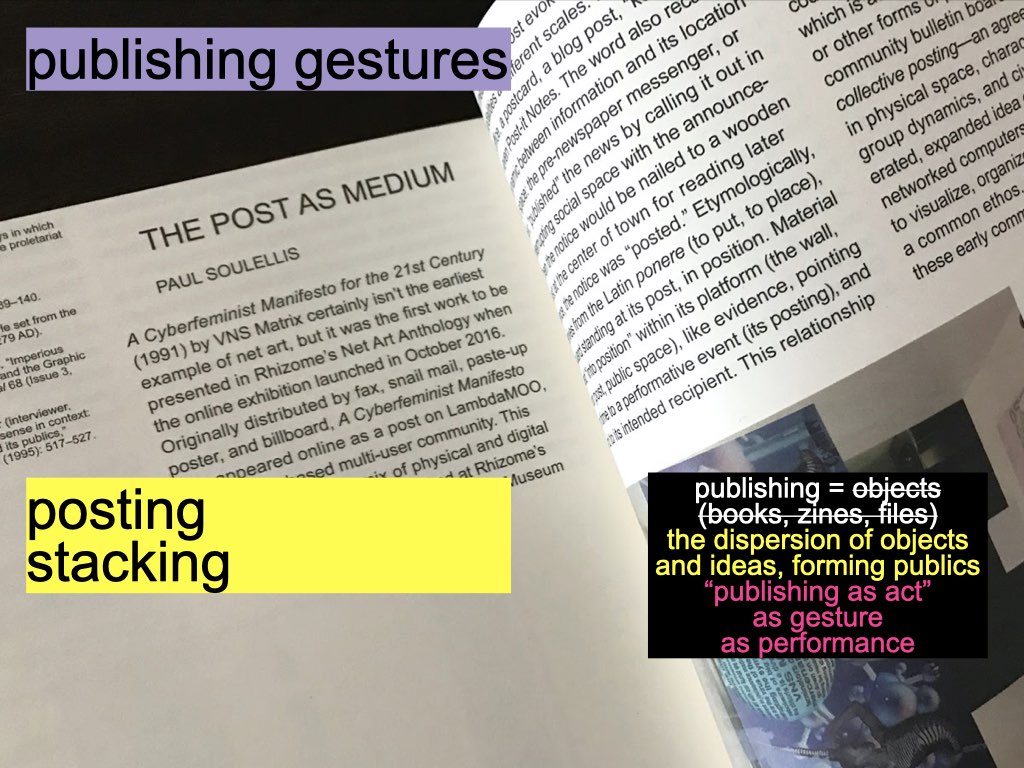
Beyond the post, I propose a few other gestures of publishing. Another one is stacking.
58 / 144
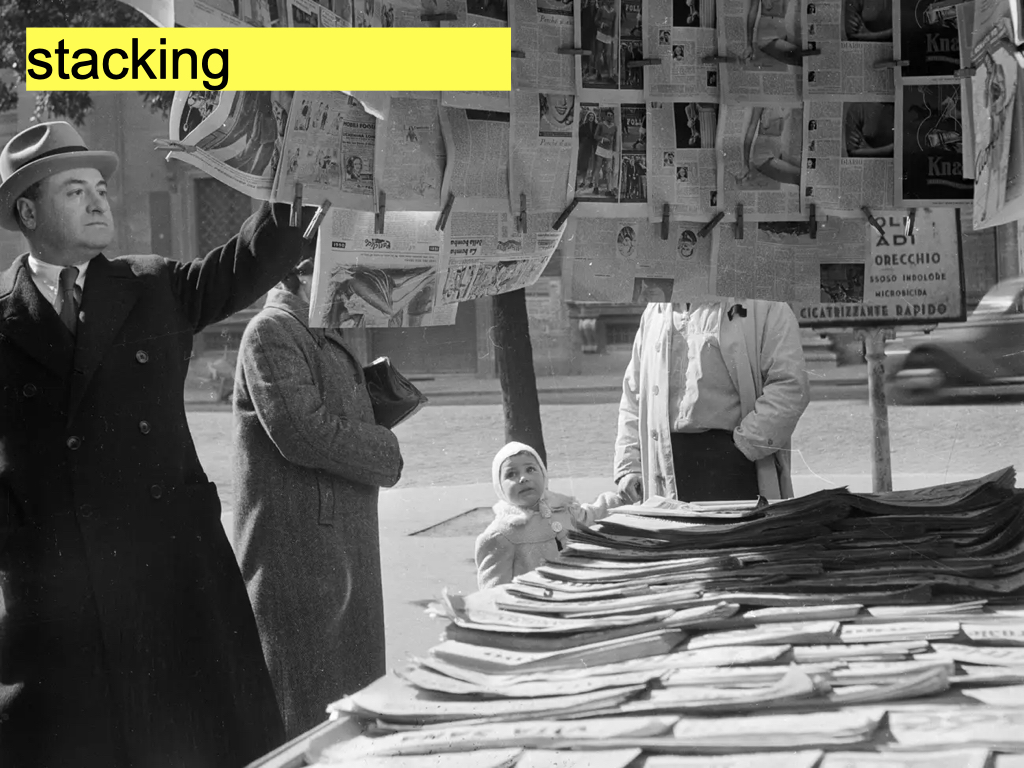
Stacking is basic too. It brings to mind one of the most common ways to distribute printed material in public space. Use gravity! If it’s not posted on a wall, it’s probably sitting flat, stacked on a horizontal surface somewhere, like at a newsstand,
59 / 144
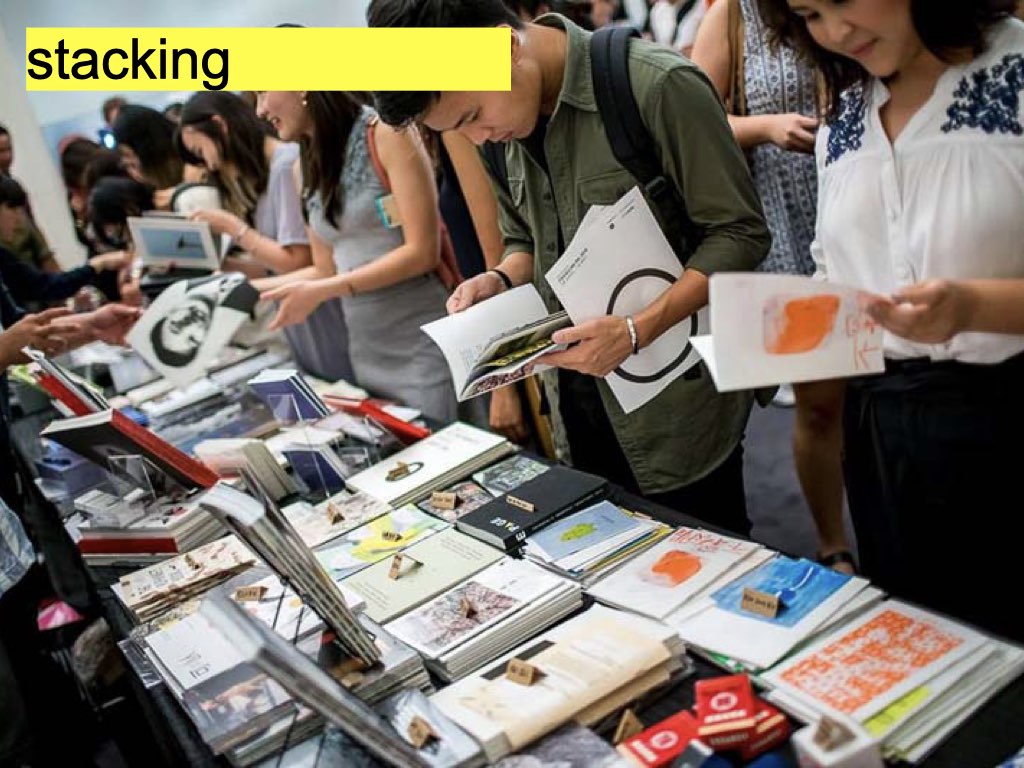
or a bookstore, or an art book fair,
60 / 144
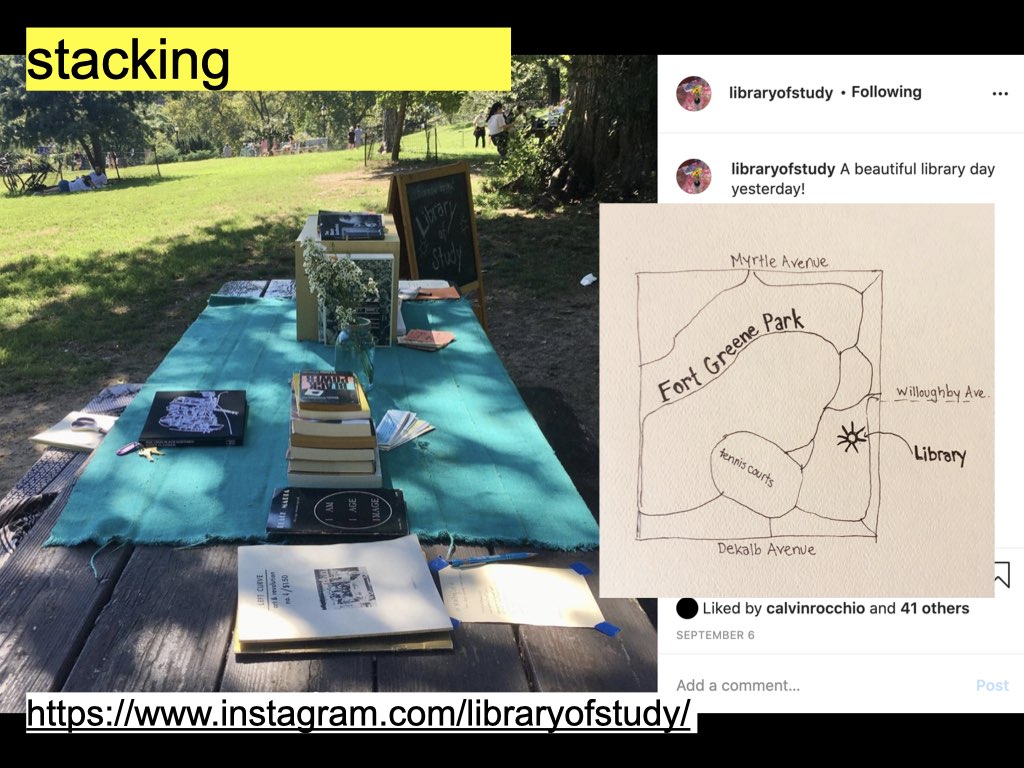
or even just the idea of putting a table out in public, for discussion and exchange.
62 / 144
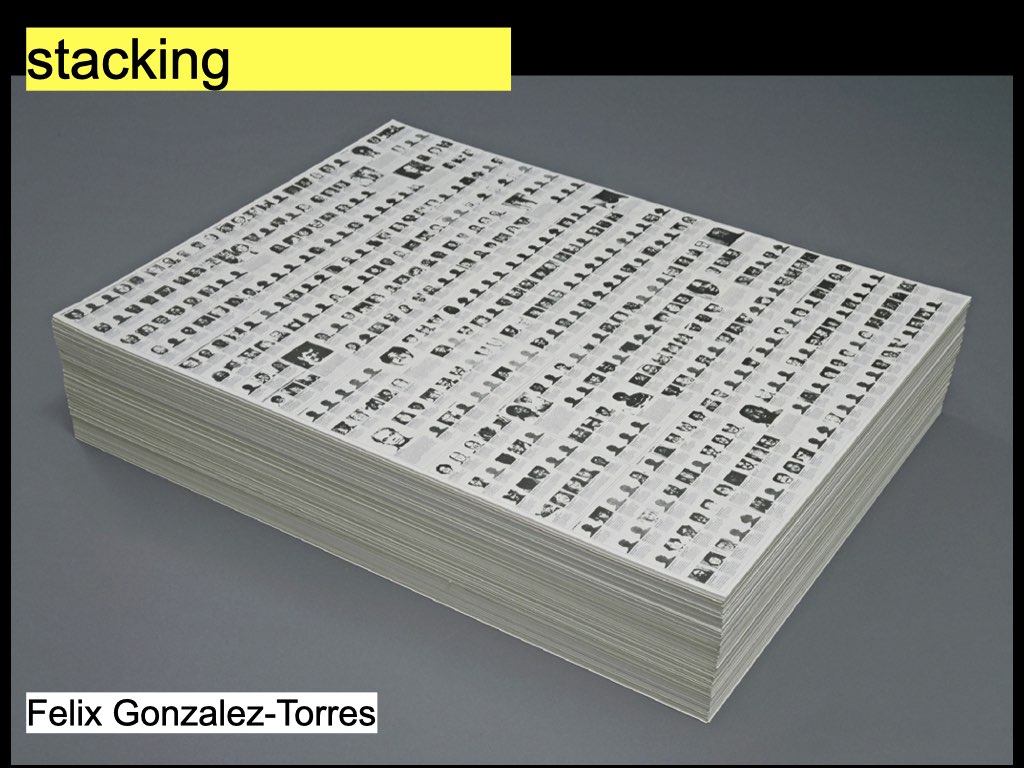
And we can’t talk about stacking without mentioning the artist Felix Gonzalez-Torres, who really invented the stack as a sculptural art form in itself.
63 / 144
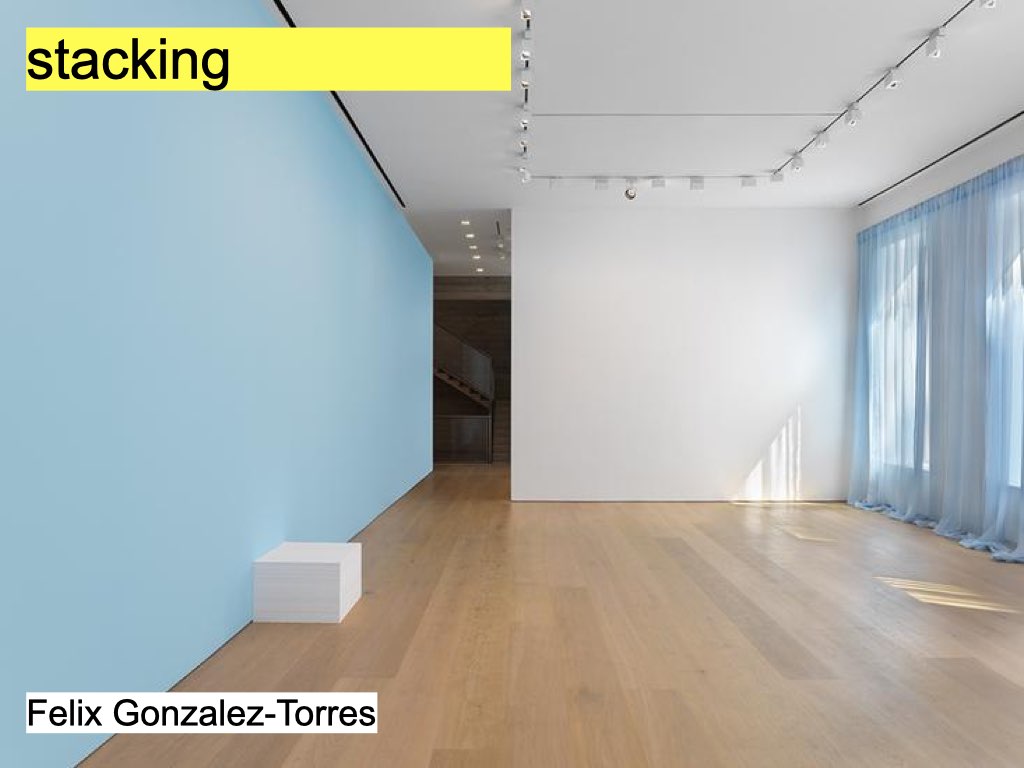
Felix’s stacks are unlimited, to be constantly replenished. It’s a different take on monumentality—I would say he’s dismantling the idea of the monument. The sculpture here is less an object and more an act of publishing that’s always disappearing and re-forming itself.
64 / 144
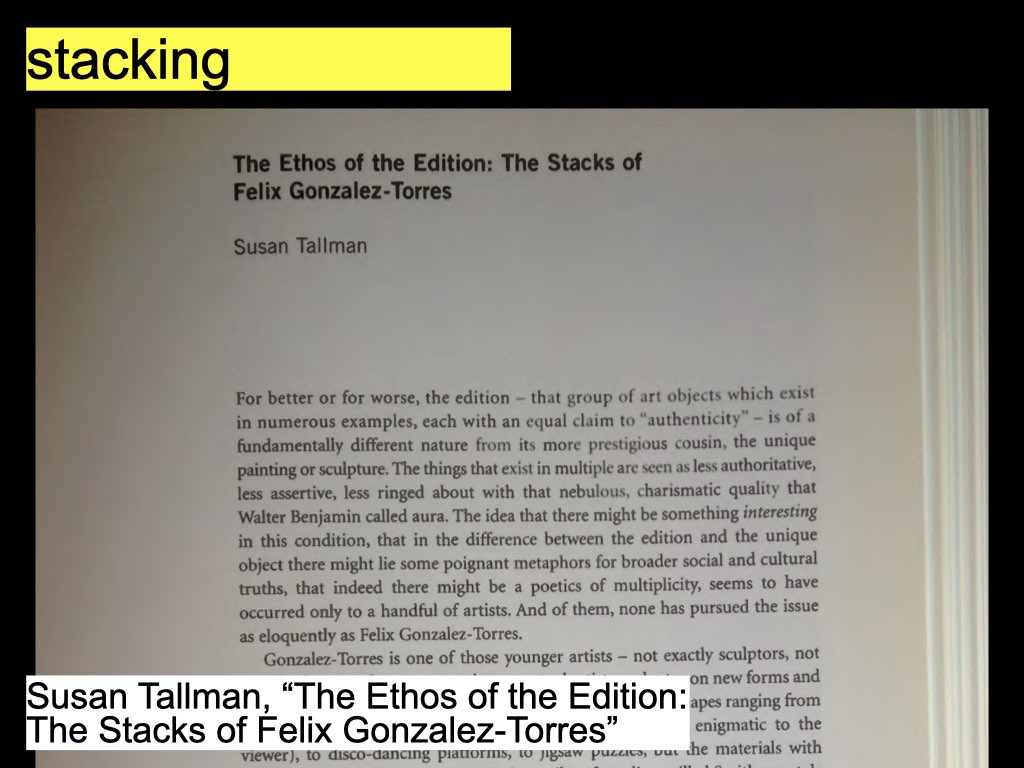
If you’re interested in reading more about this, this is the only text I’ve ever been able to find on stacks, by Susan Tallman: “The Ethos of the Edition,” writing specifically about the stacks of Felix Gonzalez-Torres.
65 / 144
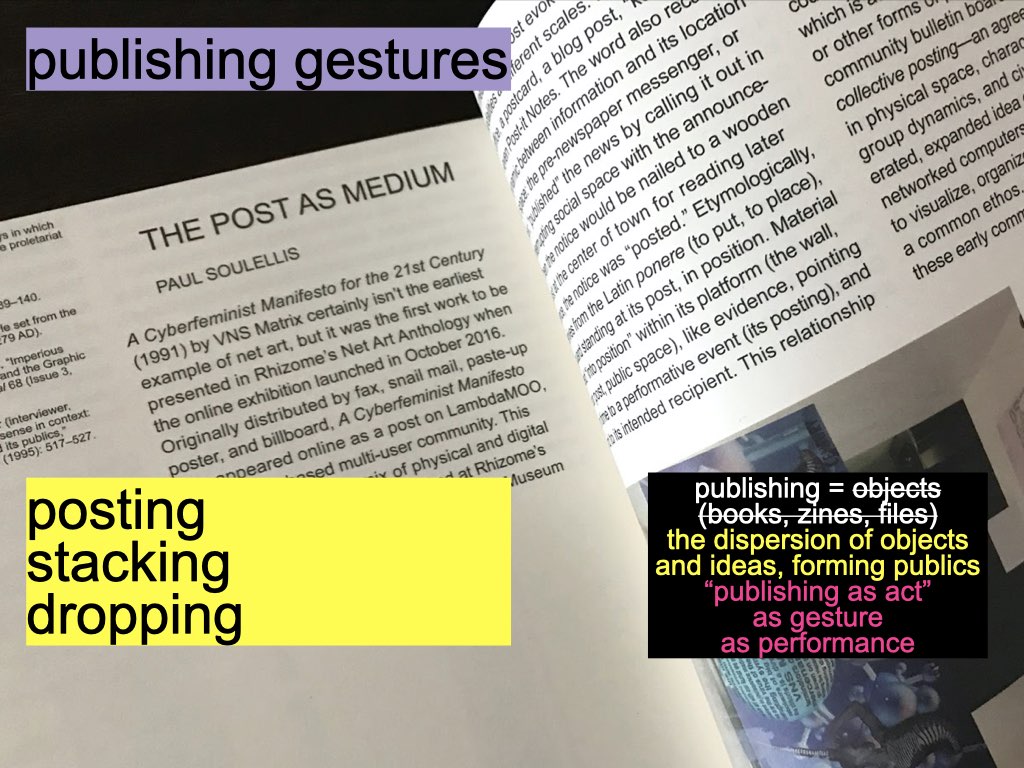
Dropping is another publishing gesture.
66 / 144
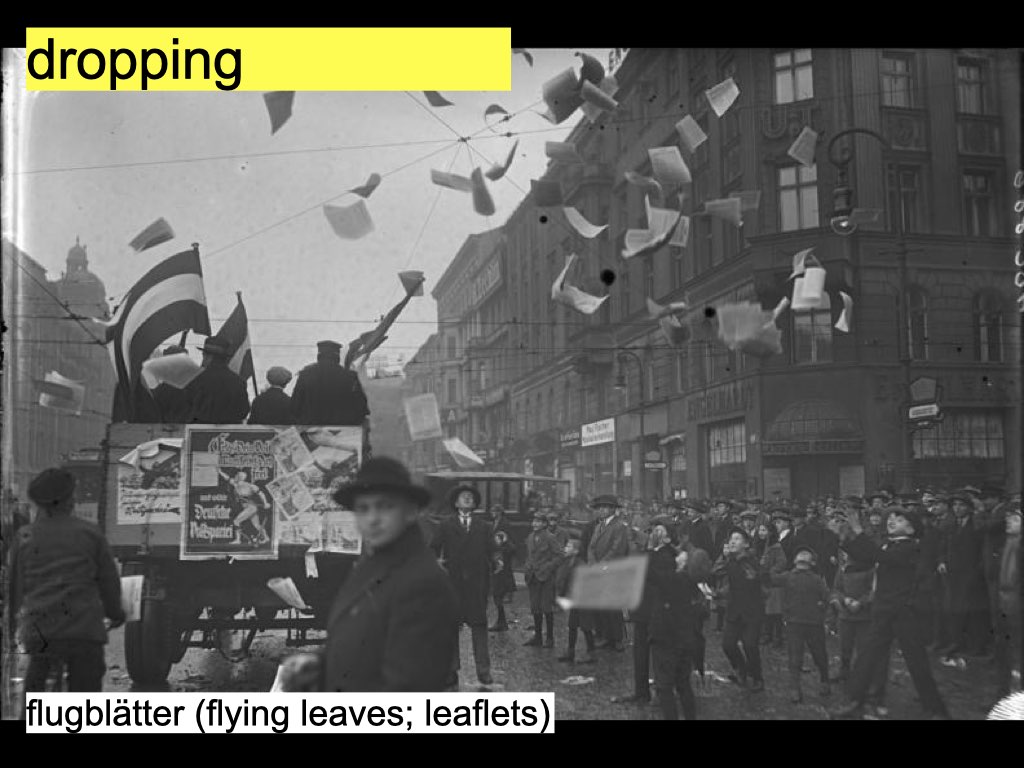
Dropping is much less common, but we know about it from images like this one,
67 / 144
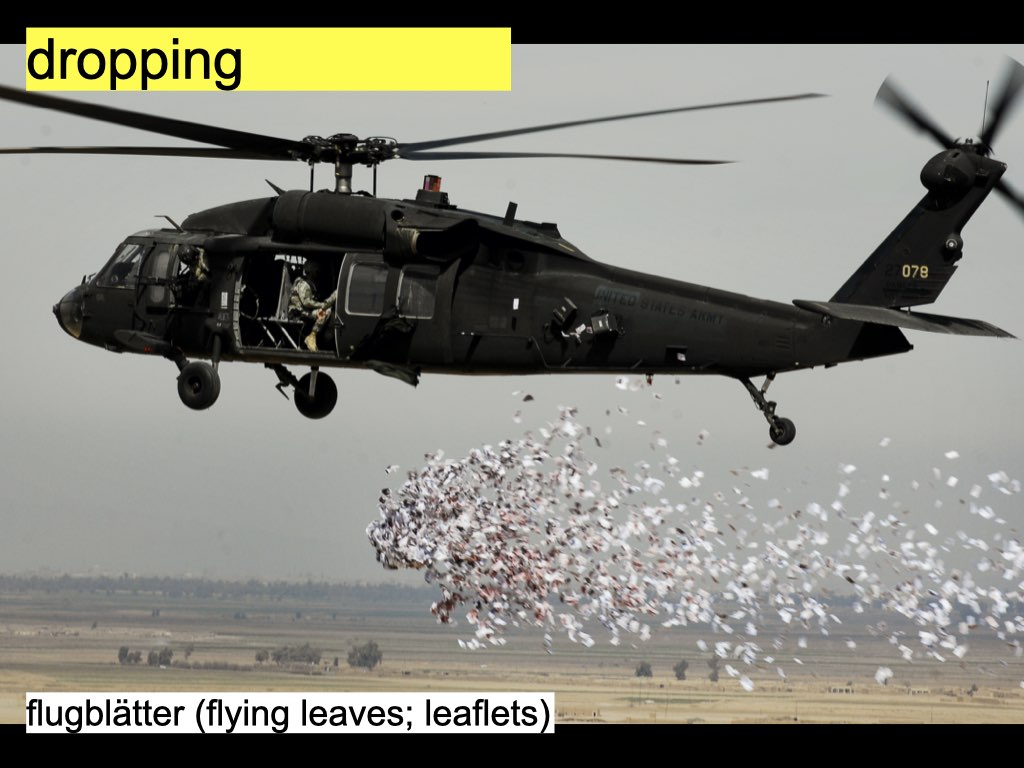
which are really associated with propaganda and the state. The idea of forcing an act of publishing onto a territory. It’s a colonialist tactic, in that the author comes at you from above,
68 / 144

and then disappears, dropping the message onto the land.
69 / 144
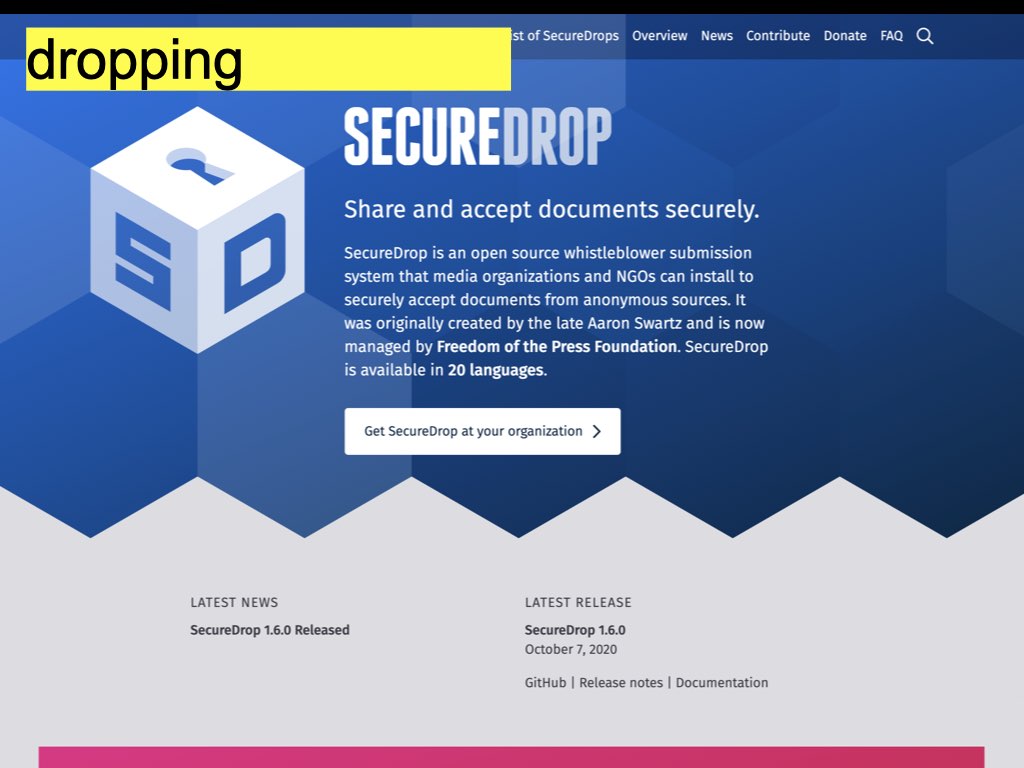
But dropping is also this—it’s the language we use to talk about transferring digital files.
70 / 144

We know dropping in a more everyday way like this—visualizing the act of publishing or sharing as passing files through the air, dropping them into someone’s device, or dropping an album.
71 / 144
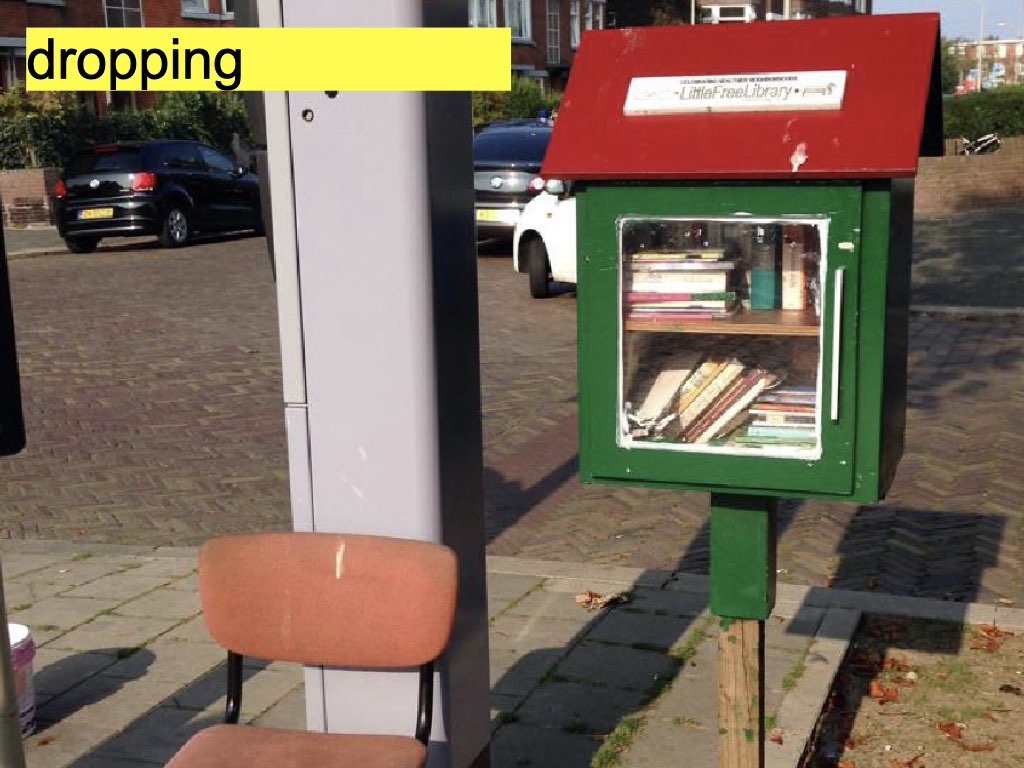
In contrast, I really see this as dropping, too. We drop books off, and we pick them up. This kind of dropping is less impersonal, almost intimate somehow, because of the physical location of these boxes in neighborhoods, in front of people’s homes.
72 / 144
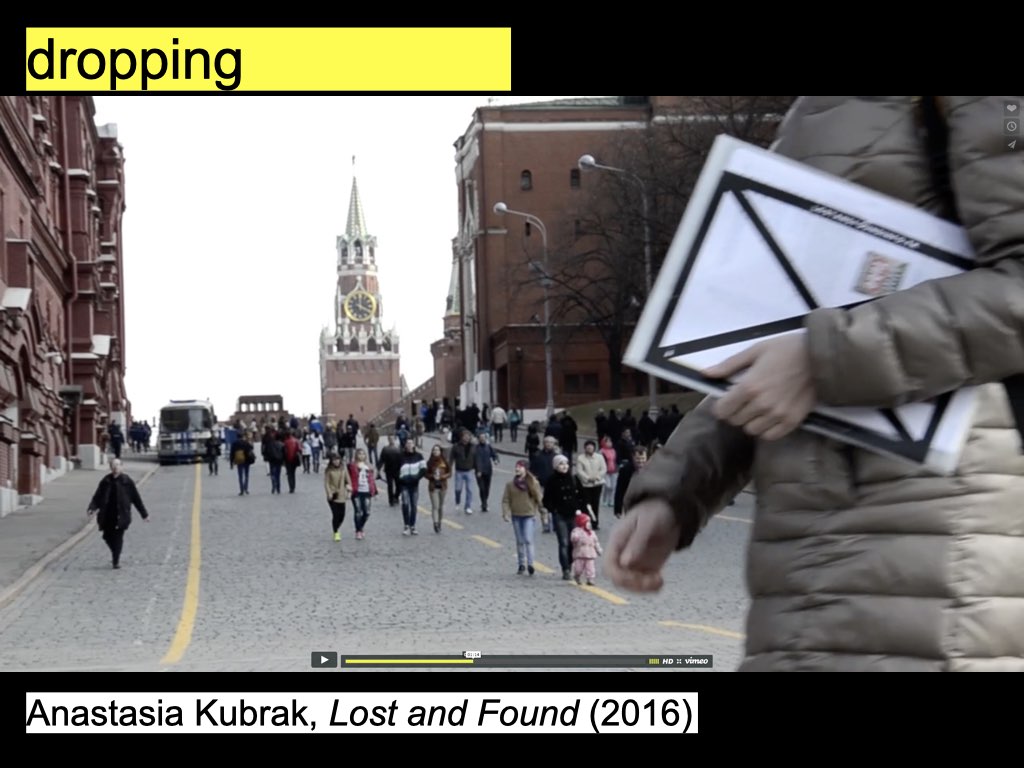
Anastasia Kubrak has a project that mixes all of these ideas, where documents censored by the Russian government are printed and left in specially marked drop points all over the city,
73 / 144

secret drop-off sites that are identified by this “X.”
74 / 144
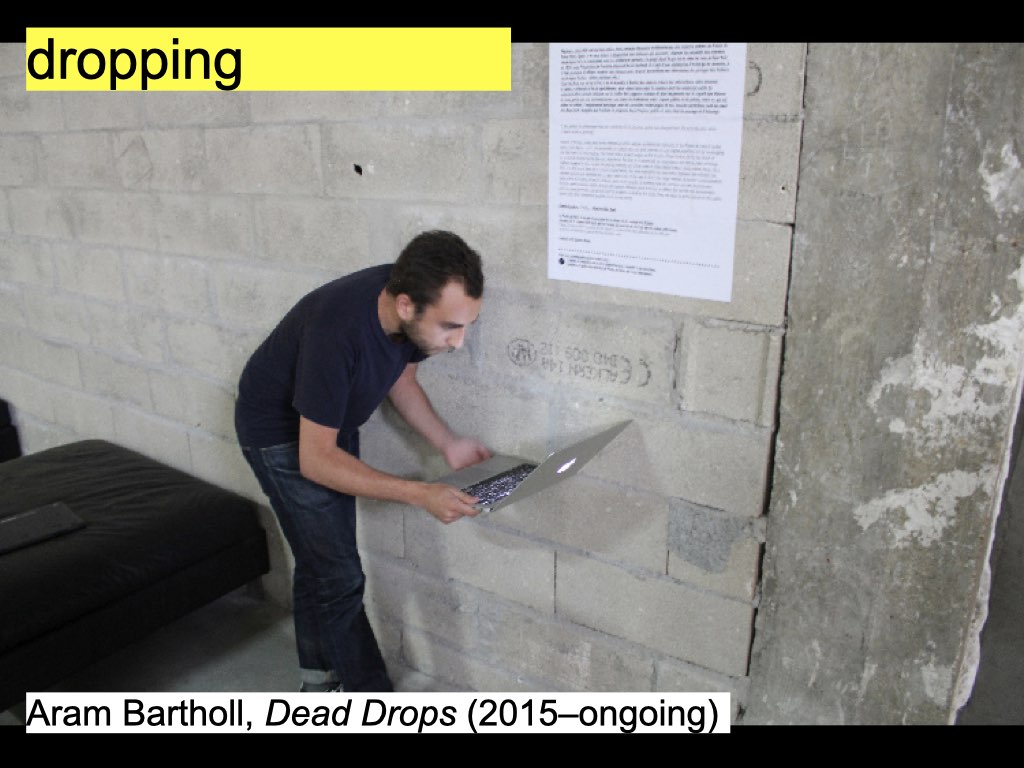
And then there’s Aram Bartholl’s Dead Drops project, which are public USB drives located all over the world, embedded in architecture. It’s an entirely offline project for the distribution of digital material.
75 / 144

The last publishing gesture that I’ll talk about is streaming,
76 / 144
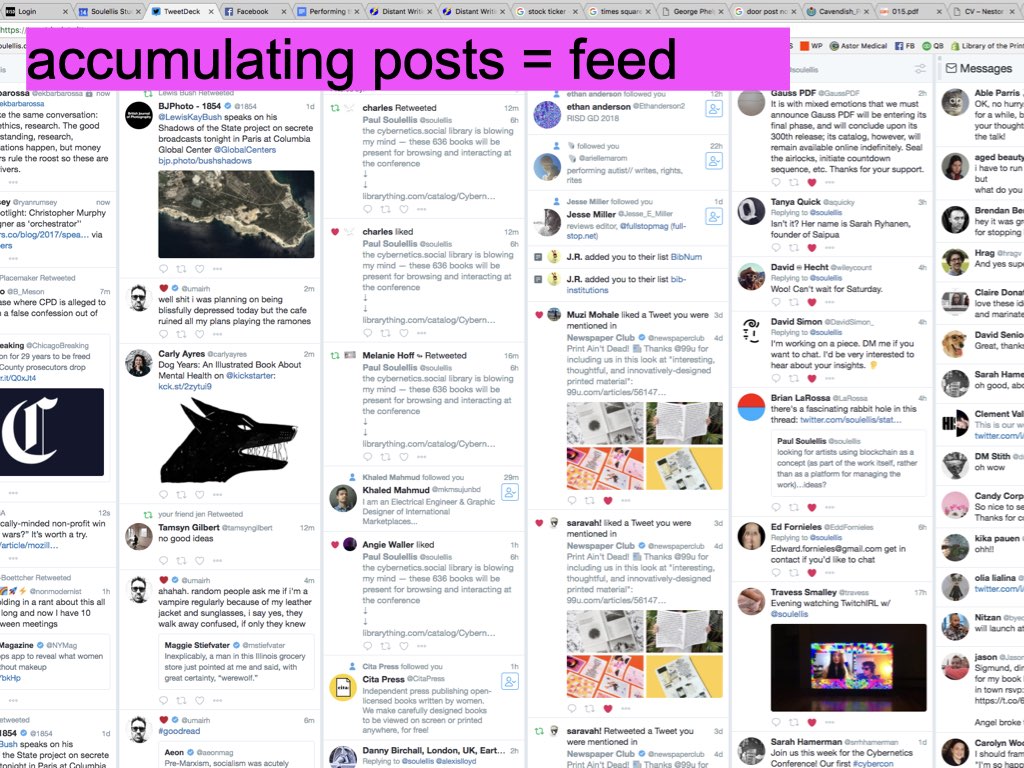
or really: feeds and streams. If you think about an individual tweet, it’s a single post. But these posts accumulate into feeds. The feed is a never-ending flow of posts. I think this is one of the most important ways to think about publishing today—the feeds we surround ourselves with, that we’re comforted by, that we nurture and take care of.
77 / 144
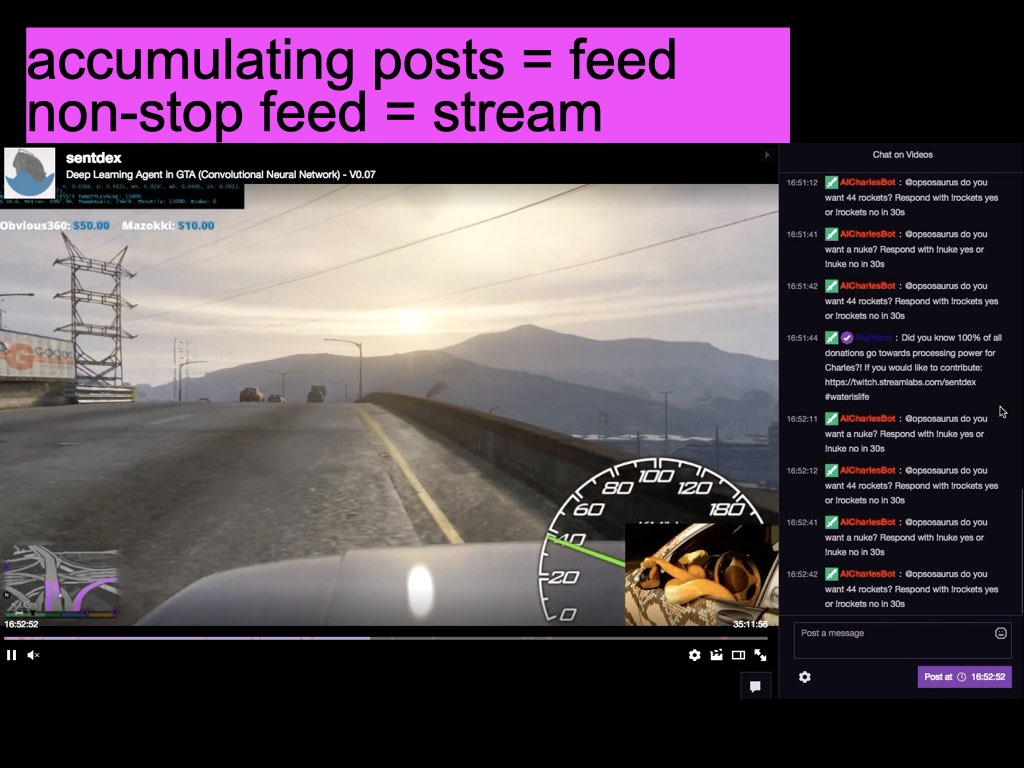
If accumulating posts are a feed, then the non-stop feed is a stream. And so we have literal streamers, who perform live on Youtube and Twitch and Tiktok, for hours or days at a time. If we had more time we could get into how this is different from the old, 20th century model of broadcasting.
78 / 144
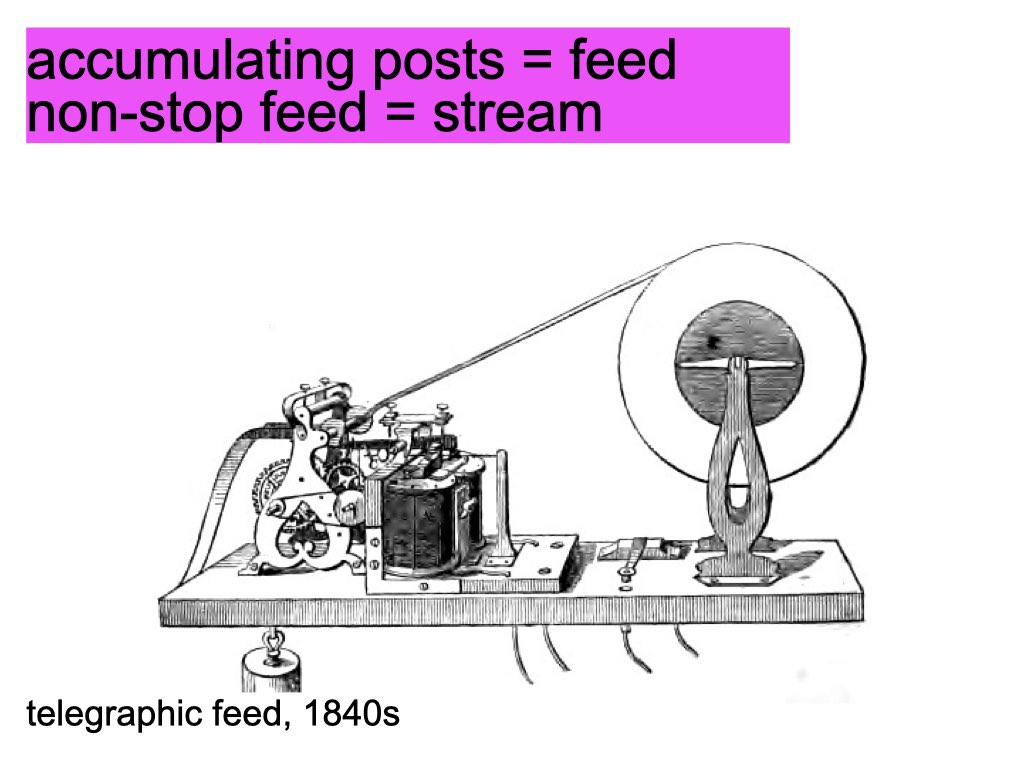
Even though it seems new, the feed has been around for quite a while; it’s a product of the industrial revolution but it’s quickly evolving into something else now, in late-stage capitalism. I can’t find any reference to the feed as a flow of information prior to the 1840s, around the sudden invention of the telegraph. It’s no accident, I think, that the photograph was also invented at this moment—it just took a while for these technologies to merge.
79 / 144
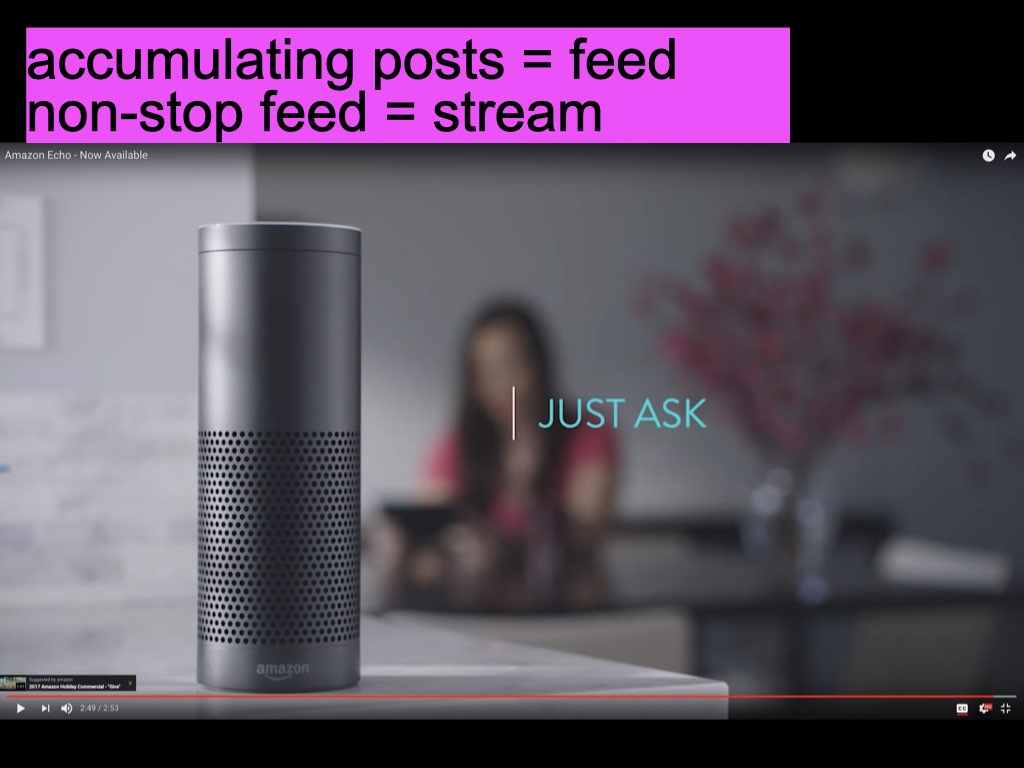
This is what our feeds are turning into today; we no longer see them or recognize them as an accumulation of posts, but we experience them like an ambient presence. If you think about the technology behind a device like this, it’s still about posting questions, and receiving answers that are posted back. But the experience is much smoother than that. It's not an interface of buttons and boxes, but of natural language.
80 / 144
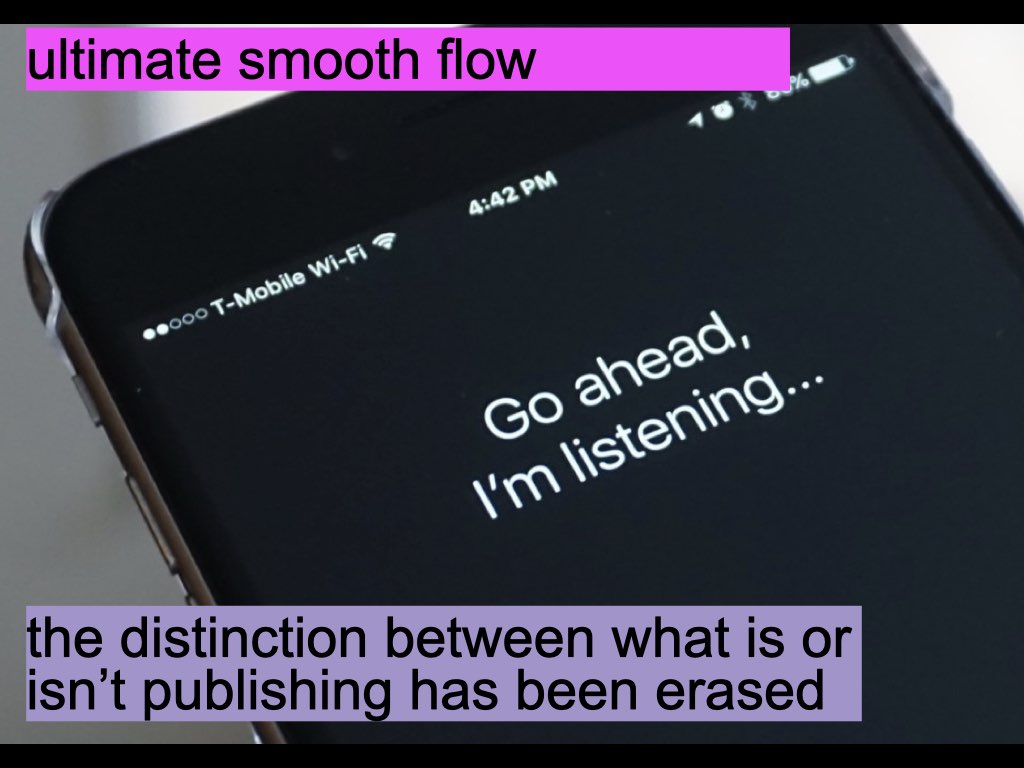
For the first time, I think those distinctions between what is or is not publishing are becoming very blurry. Very ambiguous.
81 / 144
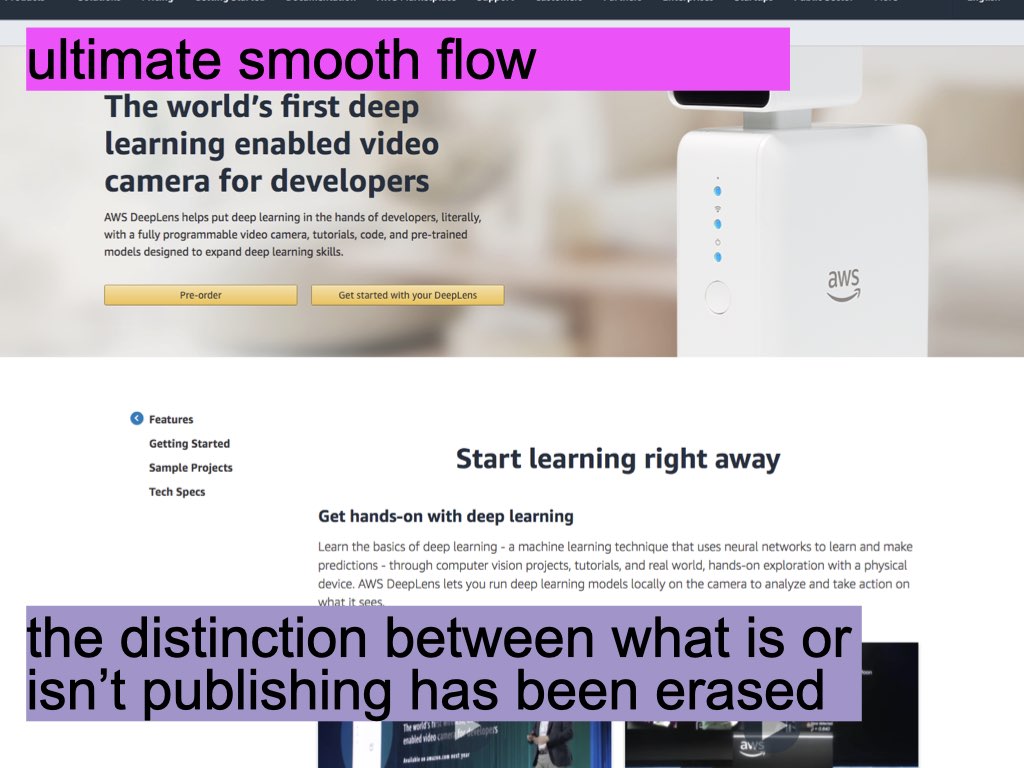
As we engage with non-stop streaming in a totalizing way, throughout all of our environments,
82 / 144
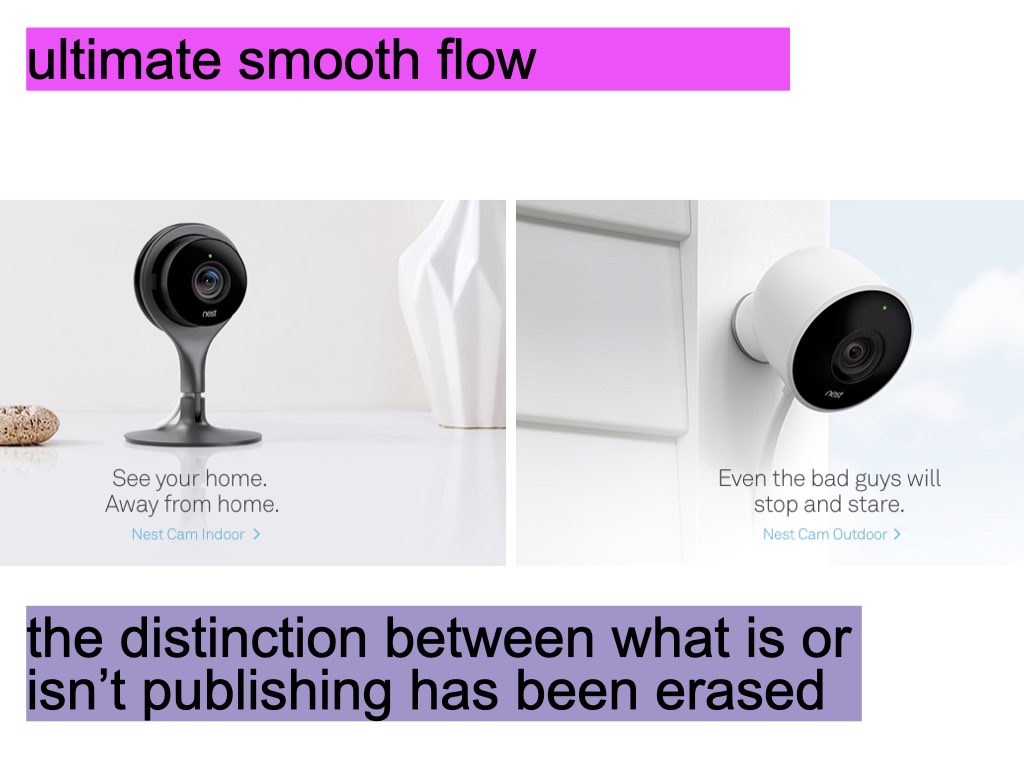
we’re seeing this collision and collapse between publishing, digital networks, and surveillance.
83 / 144
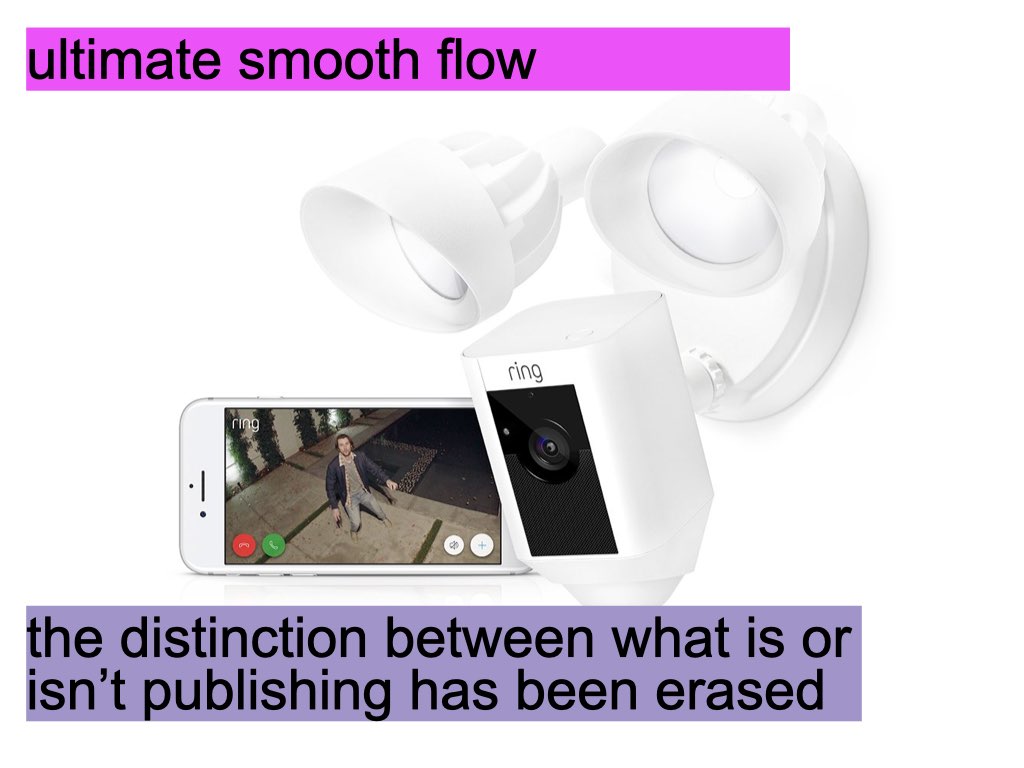
And this blurriness isn’t going anywhere. It’s becoming more and more ubiquitous and accepted. It’s a desire that we seem to have right now, as a society, to protect ourselves with these networks of seeing and listening, and the ideologies of profit and power that go along with them.
84 / 144
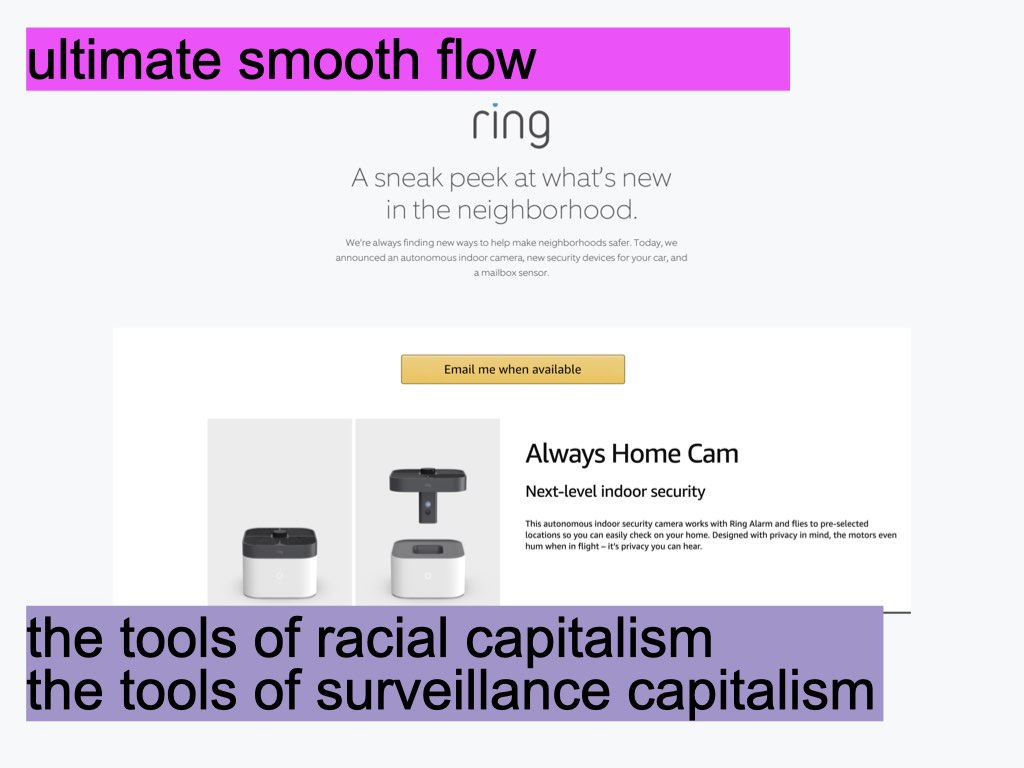
It’s crucial that we try to understand how this all works. The politics of our platforms. How the same streaming, always-on platforms that enable us to publish and communicate and entertain and protect and isolate ourselves—
85 / 144
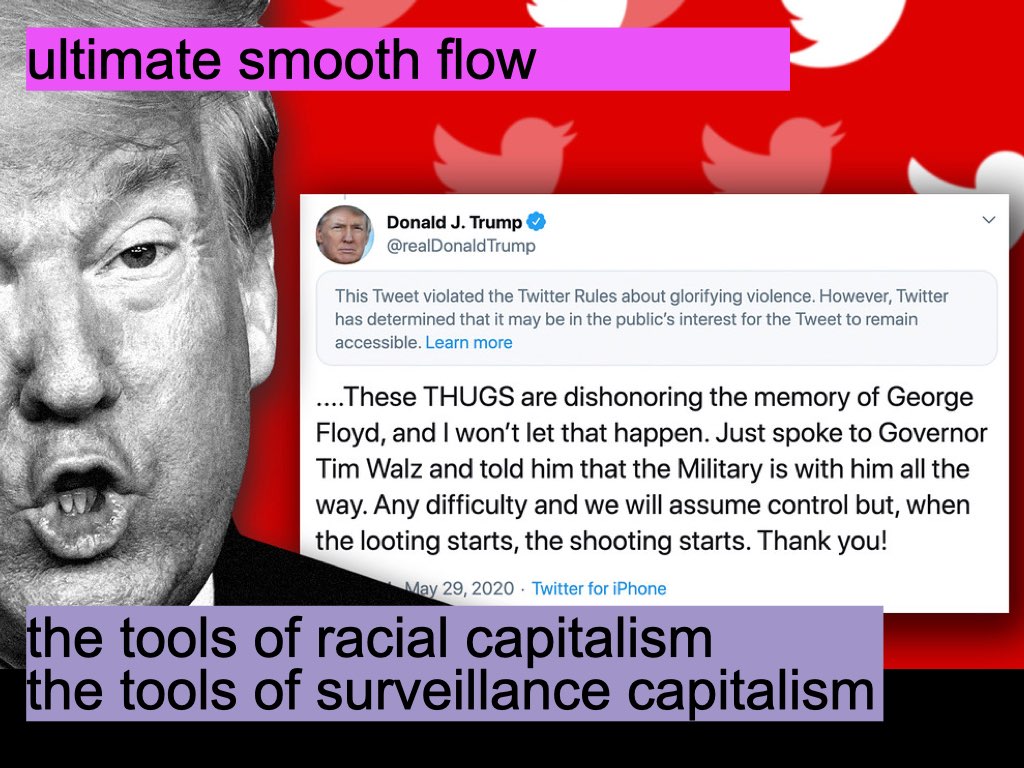
—are the very same platforms being used by capitalism to profit and to persist, and by state institutions to surveil, to minoritize, and to criminalize.
86 / 144

It’s the ultimate smooth flow of interfaces that know us and envelope us now that I’m most concerned about. Not because I don’t enjoy them—but because I do. As designers, we find ourselves in a very particular contradiction here. How do we participate in this? How do we continue to design these most perfect interfaces, knowing what we do?
87 / 144

These are questions for each of you to grapple with, as students, as working designers, as anyone invested in how design participates in our political state right now.
88 / 144
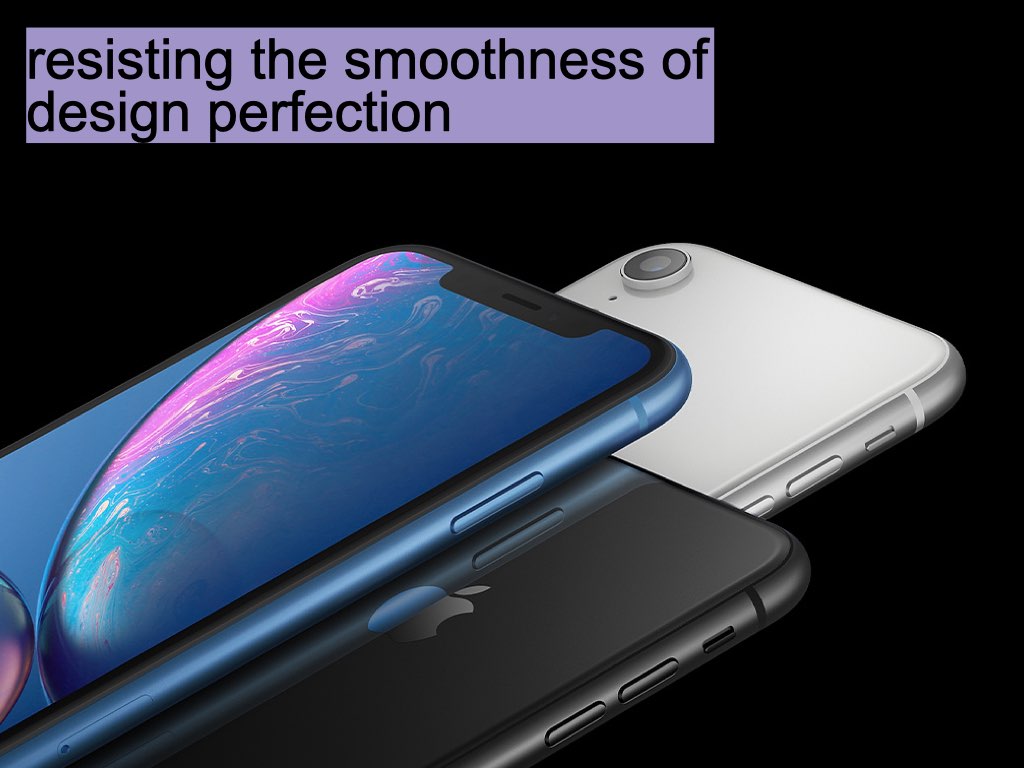
My own battle with this takes the form of a demand: to resist the smoothness of design perfection. I make this demand of myself and in my teaching. It means always questioning. More than that: always deeply examining the less visible ideologies that lurk behind the design products that govern how we live and communicate.
89 / 144
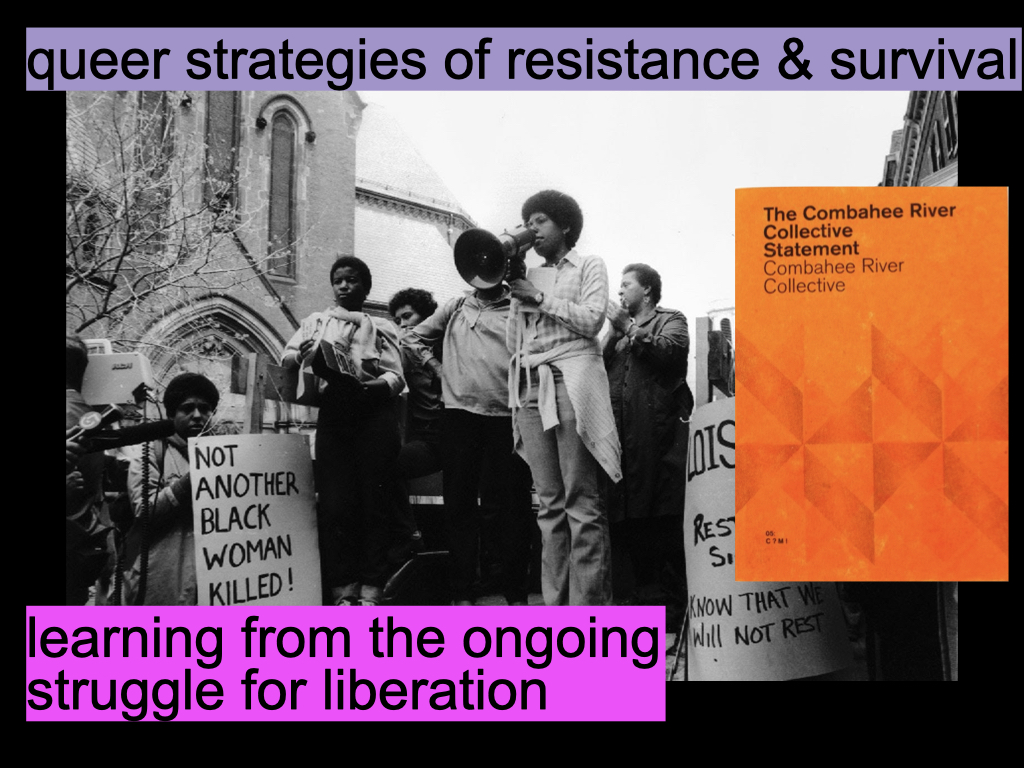
For me this means thinking about history, looking at archives as time machines, and dialing back over the course of the last 50 years to see how others have resisted and persisted. What can we learn from their ongoing struggles for liberation?
90 / 144

I’m particularly inspired by Barbara Smith, who was part of the Combahee River Collective in Boston in the 1970s, and who co-founded Kitchen Table: Women of Color Press in the early 80s.
91 / 144
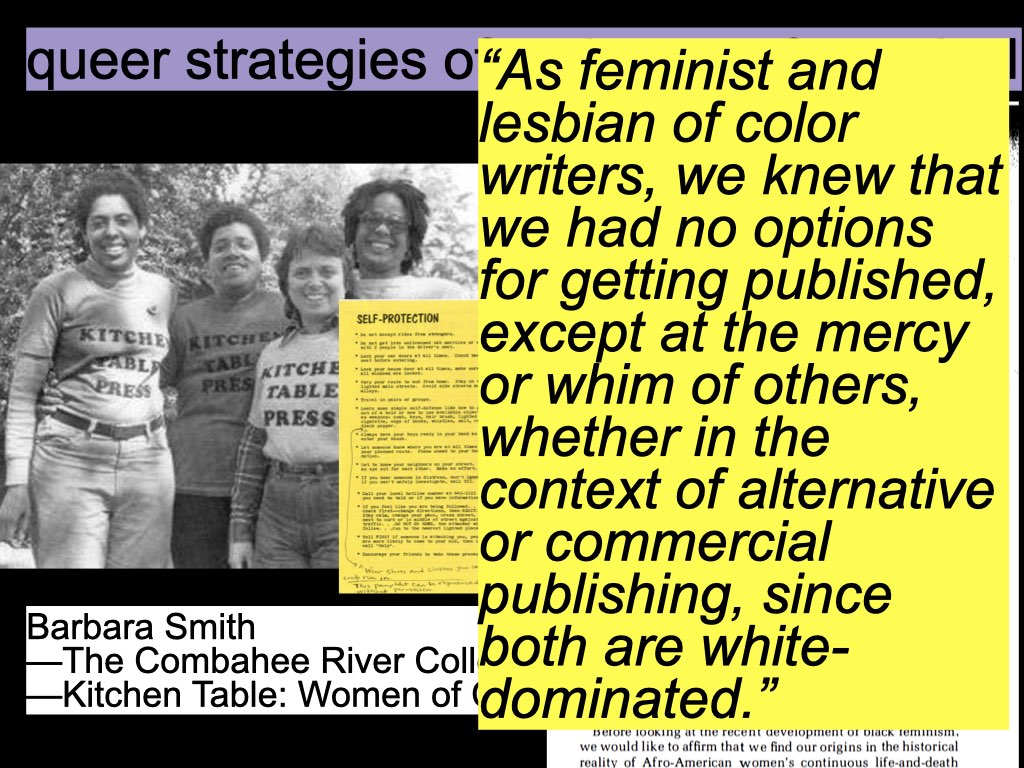
There’s a lot to learn from her, but specifically around publishing, there’s this quote. In this oral history she’s talking about a conversation she had with the poet Audre Lorde, about why she started Kitchen Table.
92 / 144
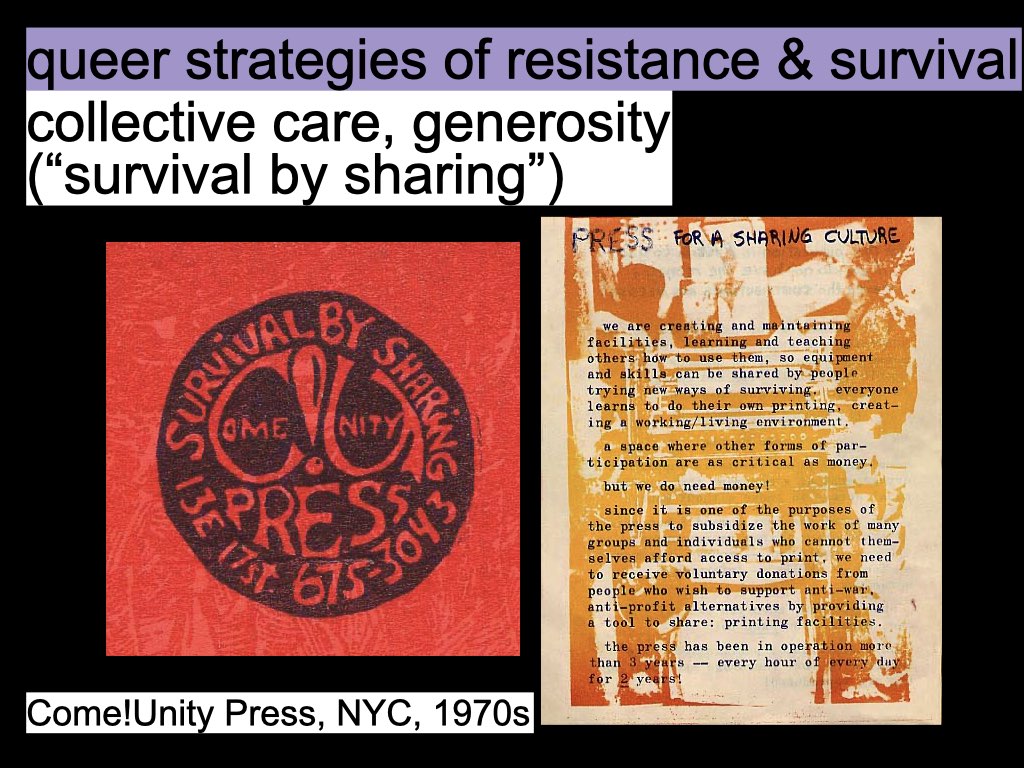
Radical publishing has been used throughout history as a form of survival, as a way to detach from mainstream structures of oppression in academia or commercial publishing, where whiteness, heteronormativity, capitalism, and settler colonialism have always been in full operation. They still are. Groups like Kitchen Table and Come!Unity show us how values like collective care and collaboration and sharing were fundamental to this kind of publishing practice.
93 / 144
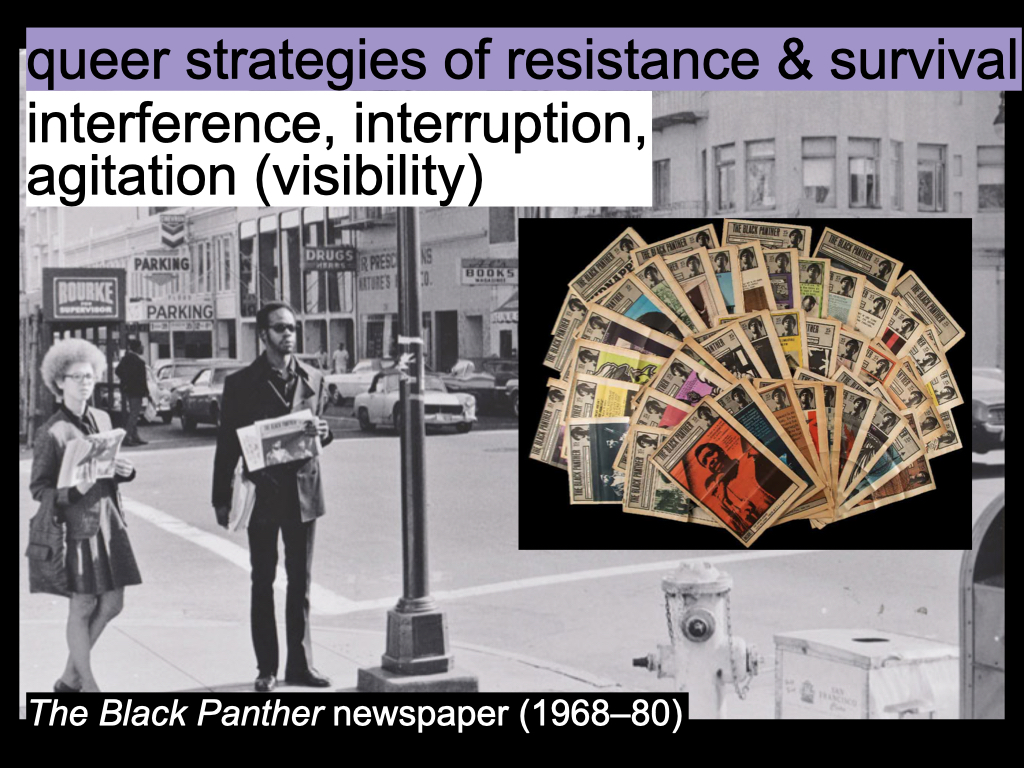
Another strategy in the ongoing movement towards liberation is using visibility to interrupt the narrative—as The Black Panthers did by distributing newspapers openly in public space. In the moment of exchange was an opportunity to engage directly, person-to-person.

